When Was the Catamaran Invented?
Look at how multi-hulled vessels have evolved over the millennia to find out when was the catamaran invented.


Stefan Kristensen
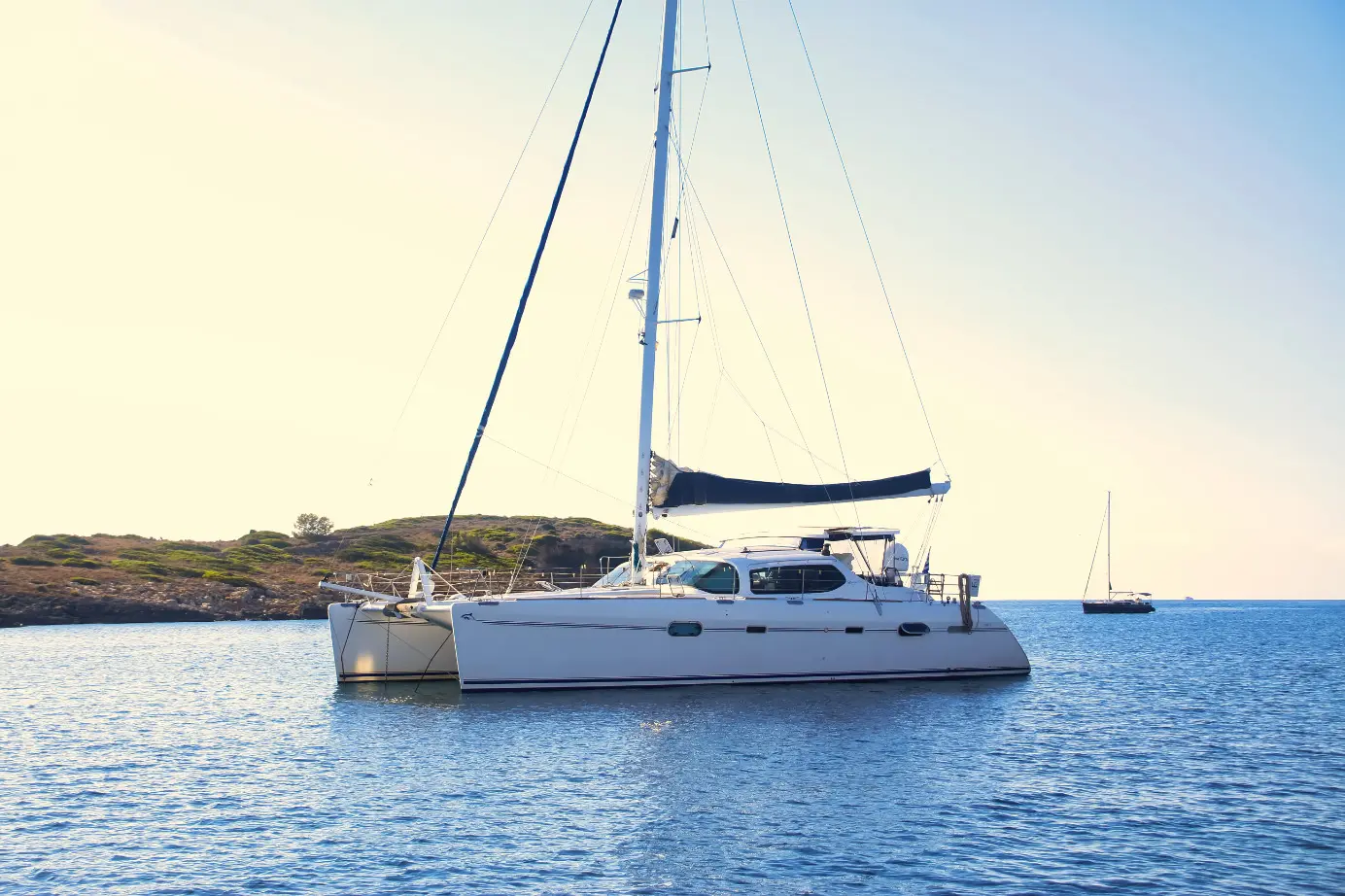
The first modern catamaran was designed and built by Nathanael Herreshoff in 1876 and patented a year later. However, the concept and construction of catamarans and vessels that operate on the same principles date all the way back to the second millennium BCE among the Austronesian people.
In the rest of the article, we are going to learn what makes a catamaran different from a traditional boat and explore the long history of the vessel’s gradual development to fully answer the question of when was the catamaran invented.
What Is So Special About a Catamaran?
Although they are often perceived as a trend or a fad, catamarans actually do have significant structural differences compared to traditional boats. Catamarans have two hulls instead of only one. The two hulls of a catamaran are joined by the bridge deck to form a single vessel.
One of the most noticeable practical differences between the catamaran and monohull boats is that catamarans are a lot more stable. This is because the beam is significantly wider than a traditional boat’s, giving the catamaran a greater initial stability, albeit with a poorer secondary stability. This makes the boat less likely to capsize, but more difficult to recover once a capsize has begun.
Catamarans also have shallower drafts and displace significantly less water than comparable traditional boats, which means they experience less resistance from the water when moving forward. This, in turn, means that catamarans, whether they are powered by sail or motors, need less energy to move the same mass at the same speed compared to a similarly sized traditional monohull boat.
What Is the History of the Catamaran’s Development?
When most people think of catamarans, the type of vessel they picture traces its history to Amaryllis , a boat designed and built by American mechanical engineer and naval architect, Nathanael Herreshoff. While only in his 20s, Herreshoff created the modern catamaran design, raced his first one in 1876, and patented it the next year.
This kickstarted the modern industry and application of catamarans, but the principles that Herreshoff made use of to design Amaryllis were not all completely new. Similar designs had been trialed by Europeans since the 17th century and used by Austronesians in the Indian and Pacific Oceans going back thousands of years. So then when was the catamaran invented?
Early Austronesian Origins
The history of catamarans among the early Austronesian people is tied to that of outrigger canoes, which are boats that are stabilized through the use of a separate floating device which sits alongside the main hull. There is controversy among academics over whether outrigger canoes developed as scaled down versions of catamarans or catamarans as expanded versions of outrigger canoes.
There is history of both types of vessel going back to the second millennium BCE, though the earliest record that Europeans have of them is from 1521, when they were observed by sailors on Ferdinand Magellan’s expedition to circumnavigate the world.
Petty, Crisp, and the English Prototypes
The first European prototype of a vessel with two hulls was designed in 1662 by famed English economist, William Petty. Although as with any catamaran, this boat was designed to use less energy, move faster, and navigate shallower waters, the concept was just too experimental for Petty’s contemporaries, and it never took off.
A few decades later, toward the end of the 17th century, English navigator and pirate, William Dampier, was on the Indian subcontinent, where he learned of vessels with multiple hulls from the native Tamil speakers. He was the first English speaker to record the word “catamaran” for these, adapting it from the Tamil word “kattumaram.”
The first catamaran built by Europeans to see use was designed and built by English captain Mayflower F. Crisp in Burma in the early 19th century. His vessel was called Original , and Crisp documented its exploits and the rationale behind his design himself in his 1849 book, A Treatise on Marine Architecture, Elucidating the Theory of the Resistance of Water .
Original remained in service for a number of years, during which it largely navigated the Gulf of Martaban, enabling trade between Southeast Asian ports situated on the gulf. In spite of Original’s success, the work of Captain Crisp did not change sailboat designs among his contemporaries.
Herreshoff and the American Catamaran
The final big development in catamaran design came in 1876, when American engineer and naval architect, Nathanael Greene Herreshoff, designed and built his first catamaran, Amaryllis . Herreshoff patented this design in 1877, the year following Amaryllis’ maiden voyage.
Whether due to changes in design or the fact that he was the first to formally patent his design, many consider Amaryllis to be the first modern catamaran and therefore Nathanael Herreshoff to be the inventor of the catamaran, as we know it, in 1876.
Interestingly, Herreshoff never referred to his design as a catamaran in the patent . The patent itself is simply titled “Improvement in Construction of Sailing-Vessels,” and Herreshoff makes references to “the vessel” and “my invention” but never uses the Tamil word that the English had previously adopted for the design.
Catamarans saw a lull in popularity once again after Herreshoff’s design won and was subsequently excluded from a lot of yacht clubs for what was perceived to be unfair competition.
The catamaran design saw its final and longest lasting resurgence in the mid-20th century, when its construction and use started getting picked up across the globe. Perhaps the most popular adoption was by American surfing legend, Hobie Alter.
Alter’s company, Hobie Cat, manufactured and sold small catamarans bearing the same name. The Hobie Cats have become a world standard, with one vessel, the Hobie 16, having sold more than 100,000 units since manufacturing began.
Most people offer Nathanael Herreshoff’s Amaryllis in 1876 as the answer when asked when was the catamaran invented. While it is considered the first modern catamaran, we have learned today about the thousands of years of gradual development across cultures and continents that have shaped the vessel, from early Austronesian rafts to the Hobie Cats of yesteryear.
Sign up for more like this.

What Are Catamarans And Their History?
Catamarans are boats with two connected hulls that are joined by a bridge. Because they are faster, more stable, and capable of carrying larger cargo than their monohull counterparts, catamarans are growing in popularity.
As a result, designers and owners have greater freedom to accommodate space needs in terms of size and usefulness than they would with single-hulled vessels.
The name catamaran came from the Tamil word “kattumaram” which basically meant “logs which were bound together”. These traditional watercraft were basically used on the south coast of India and Srilanka. They were dated back to as early as the 5th century when they were used to transport troops from one island to another.
Let us get into more details to learn more about the different types of catamarans and their functions.
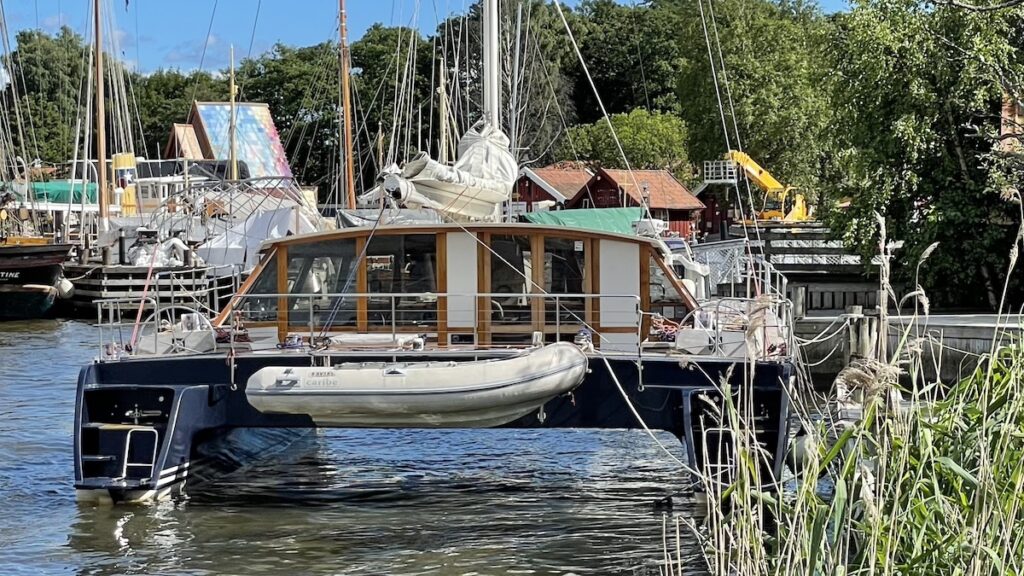
What are the different types of catamarans?
Catamarans are mainly divided into two categories: sailing and power catamarans, however, both categories can be split into smaller groups by their size and use.
Sailing catamarans
These types of catamarans are mainly propelled with help of sails. The sails act as wings with which the vessel moves forward with the help of wind energy. The sailing catamarans have advanced significantly in recent years in terms of both design and performance attributes. Sailing catamarans are further subdivided based on their dimensions and functions and are classified into,
Small, mini, or sports catamarans
Depending on the size, these are also known as leisure catamarans and can carry a load of 6 persons on average. You’ve definitely seen some of them speeding through your local beach waters on hot, sunny weekends; some of them are made to be driven by one person. Those designed for use in sports have a trapeze that enables one to hike out and serve as a counterweight.
Small-day sailing cats are well-liked because they offer a secure and straightforward learning environment, and you can see fleets of them in resorts where guests with little to no sailing experience utilize them. These little cats are often made of roto-molded plastic or fiberglass, and as they frequently lack auxiliary motors, sails are their only means of propulsion
A trampoline that spans the two hulls of the sports catamarans acts as a bridge so that individuals can move from one to the other without falling into the water. They may be launched and landed from a beach as opposed to a dock because of their modest size. They have a rotating mast and a mainsail with full-length battens.
Cruising Catamarans
In the worlds of long-distance cruising and bareboat chartering, larger cruising cats have dominated. These are more stable than their monohull competitors, allowing them to securely transport people across continents. These are more stable than their monohull competitors, allowing them to securely transport people across continents.
For maneuverability, charter cats frequently have two engines—one in each hull—as well as a mast that holds a mainsail and at least one headsail.
Nowadays, cruising catamarans are more widely available than monohulls at bareboat charter firms with tropical bases, and those numbers are rising in places like the Mediterranean.
Power catamarans
Power catamarans, often known as “multi-hull powerboats” or “power cats,” are vessels without masts or sails but with larger and more powerful engines. They can be the most perfect choice for your first boat if you enjoy offshore fishing or other water sports. You get a great balance of performance, stability, and maneuverability with these powerboats. Power cats come in a range of different sizes and shapes. In terms of dimensions and functions, they are also divided into,
Center console fishing catamarans
The fishing industry is flooded with smaller power cat brands, while bareboat charter and cruise platforms are seeing the emergence of larger ones. The multi-hull performance boat frequently has a center console driver layout. They can reach higher top speeds thanks to their higher horsepower, but these cats also need to be strengthened hulls to support the weight and power of these engines.
When used for fishing, normally lesser than 50 ft, there are several options available for live wells, rod holders, gear storage, and built-in coolers for both fish and beverages. Depending on the length and design elements of the boat, certain consoles may locate closer to the bow or aft of the vessel.
Offshore powerboat racing catamarans
Offshore powerboat racing is the aquatic equivalent of off-road auto racing. Since its inception in the late 1960s, offshore racing has changed drastically.
Though V-bottom powerboat classes still exist, twin-engine catamarans with top speeds of 170 MPH in the most powerful classes dominate the sport.
The offshore race course may be the most dynamic setting in all of the motorsports because of the constant fluctuations in a swell, wind, tide, current, and other factors. The track might abruptly change from being friendly to antagonistic.
These boats are designed and built such that they are both lightweight but extremely strong using the most advanced materials like carbon fiber and Kevlar . Manufacturing methods such as infusion are adopted to make sure the properties of the materials are not lost during the production stages.
Motor yachts and ferries
For their roominess and speed, catamaran designs have also become popular among motor yachts and commercial passenger ferries. These cruise-centric yachts offer homelike livability for avid travelers, are fuel efficient, and are fairly intuitive to run.
Motor yacht catamarans have been designed with larger living spaces in mind, as well as more outdoor recreation places. The huge fly bridges provide additional space for relaxing and socializing, and electric boat davits make lifting the dinghy simple. Daily tasks like cooking can be done with ease because catamarans don’t heel.
Why Is There A Shift In Trend From Monohulls To Catamarans?
Recently, more and more often you can find catamarans in the harbors of large cities and small resorts. It can be unequivocally argued that catamarans are gaining popularity among both beginners and experienced sailors and even celebrities. But what makes them gain this popularity?
Catamarans In Terms Of Function And Utility
The enormous interior space expansion can provide the owners considerably more freedom to select furnishings without regard to size limits and more room for additional appliances like washers and dryers, which can make life on board much easier.
Due to their broader decks and roomier interiors, catamarans are frequently employed as party boats. The deck can accommodate more people without giving them the impression of being crammed into a small space.
In terms of storage, catamarans offer more alternatives than monohulls because both hulls can serve a variety of purposes, increasing the vessel’s overall capacity as well.
Catamarans are typically utilized as party boats since they have bigger deck spaces and greater room for movement. The deck can also accommodate more people without giving them the impression of being confined in a small space.
If any equipment breaks down, there is always a backup. For instance, if one of the engines on the port hull fails, we can always use the starboard engine to re-enter landfall. Likewise, if a generator breaks down, there is always a second generator that can be utilized as a backup.
Catamarans In Terms Of Performance And Stability
Due to the narrow hulls of catamarans, which serve to reduce drag forces, they frequently outperform monohulls. On performance power catamarans, the area in between the two hulls known as the “Tunnel” is built in a similar way to an aerofoil so that it behaves like a wing, boosting the aerodynamic lift forces and enhancing the overall effectiveness and top-end speeds of the craft.
Due to their stronger lift forces and lower water friction than monohulls, catamarans typically have a better fuel economy. This is because the strain placed on the engines as a whole is reduced, resulting in less fuel being used.
In terms of roll stability, catamarans are often more stable than monohulls. This offers them an advantage in terms of comfort and the ability to carry out various activities onboard the vessel with ease, as well as lowering the possibility of passengers falling on board. Because they are less likely to make passengers seasick, catamarans are typically used as ferries or passenger ships.
Catamarans provide a more comfortable ride whether they are in shallow water, deep water, or at anchor; they have a decreased chance of keeling over or capsizing in heavy winds.
Also, catamarans have a much lower draft when compared to their mono hull counterpart’s allowing them to easily ply over shallower waters.
What Are The Potential Drawbacks Of Catamarans?
Catamarans have a few minor limitations, much like any other kind of boat:
Finding dock space is frequently challenging and expensive for catamarans because they take up more room.
Power and sailing cats can both smash into the bridge deck when heading to the weather because of the way that they are built.
Additionally, because they have two hulls instead of one, sailing cats can’t necessarily aim as high into the wind as monohulls can.
Overall, a catamaran allows for greater speeds, but at the expense of much-reduced vessel control. Knowing when to accelerate and when to slow down is difficult when sailing a catamaran. A catamaran can be readily overturned in sea conditions that a monohull can maneuver securely in.
Finally, while it may be alluring to add more weight in a catamaran due to the space it provides, doing so will almost certainly degrade the performance of either power or sailing cat—something that is less of an issue on their monohull counterparts.
Catamarans are a growing trend due to their better advantages over their monohull counterparts. Despite having an ancient fundamental design, catamarans are a modern boating alternative that can be used by any boater for both commercial and leisure uses.
- Recent Posts
- The Role of Cargo Ships in Global Trade – August 22, 2024
- Report: Yang Ming’s YM Mobility Explosion at Ningbo-Zhoushan Port – August 9, 2024
- Understanding Drillships: Types, Key Features and Advancements – August 1, 2024
About the author
I worked as an officer in the deck department on various types of vessels, including oil and chemical tankers, LPG carriers, and even reefer and TSHD in the early years. Currently employed as Marine Surveyor carrying cargo, draft, bunker, and warranty survey.
Latest posts

The Quality Control Process in Marine Manufacturing
Companies in the marine manufacturing space must have tight and effective quality control processes. What steps should an effective quality control process include?

The Role of Cargo Ships in Global Trade
Contents show Volume of Goods Transported by Sea Key Global Trade Routes Economic Impact of Maritime Shipping Types of Cargo Commonly Transported Environmental Considerations Conclusion Cargo ships are the lifeline […]

What Are AGVs? Automation Becoming Increasingly Common in Seaports
What are AGVs? Automated guided vehicles can minimize the troubles of manual operations and enhance seaport operations.

A Complete Catamaran Guide
- Post Written By: Boater Jer
- Published: January 26, 2020
- Updated: November 27, 2020

Disclaimer: You might notice that we recommend products in some articles. We may earn a commission for referring you if you click the link and buy a product.
We only recommend products we’ve tried/tested/own (that’s why you won’t find thousands of affiliate links on my site). If you have experience with one of the products we’ve mentioned, please share your experiences in the comments at the end.
There you are, out on the water when a strange craft approaches. Is it a sailboat? It sure looks like one until it turns to face you. That’s when you notice this boat doesn’t have just one hull. It has two hulls and it’s called a catamaran.
Catamarans are unique, and highly stable watercraft. We’ll explore all the ins and outs of sailing the waters in one of these weird, and awesome multi-hulled craft. Join me as we explore the wild world of sailing catamarans.
A History Of The Catamaran
It is believed that the first people to use a catamaran design were those living in Australasia.
The succession of boat design in this region was actually very interesting. The beginning of boats in the area was simple, albeit conventional rafts. These were fashioned from logs strewn together with plant fiber lashings such as those formed using bamboo fiber.
Catamaran Evolution
The conventional raft gave way to a minimal raft. This design was basically a conventional raft with two cross beams added in the form of logs. These would be eventually hollowed out to improve buoyancy.
The next step in the evolution of boats in the Australasian region was the double canoe. This proved to be the first real catamarans.
After some time, the form evolved further into the asymmetrical double canoe design. In this design, one canoe was large and the other attached canoe was smaller.
The asymmetrical design quickly evolved into the single-outrigger boat like the one shown in the photo below.
The final stage of the evolution of the catamaran in the region was to gain a second outrigger. This in effect created the trimaran with the single central hull and dual outriggers.
Eye Witness Accounts Of Catamarans
In 1697, William Dampier wrote of witnessing a type of seafaring vessel off the coast of Coromandel. He noted how the locals called the type of boat a catamaran. He also noted that it had multiple hulls (logs) and that they were small vessels that the person operating would have to hang partway into the water, straddling the hull (log).
The name catamaran came from the Tamil. And yet, it was easily applied by the European visitors to the two hulled sailing vessels that sped across the water in the region.
Although Dampier may have described the catamaran in the 1690s, the type of boat was actually used as early as the 5th century by the Tamil Chola dynasty. They used boats to move their troops from one island to another. Using this design of boat allowed them to travel heavy, travel quickly and was partially responsible for the conquering of neighboring Burma, Malaysia, and Indonesia.
Building A Boat – Basics Of Catamaran Construction
A boat is usually thought of as being a single-hulled vessel that travels along the surface of the water. It can have multiple types, shapes, and designs of the hull. However, it is often only thought of as having a single hull. But, what if it had two hulls? Would that be like taking two separate boats, and making a raft over both of them? In essence, that is exactly what a catamaran is: two boats made into one.
Advantages Of Multiple Hulls
- More stability than a monohull
- Wide supporting base allows for larger sails than monohull craft of the same length
- Hull does not require the deep-running keel of a standard monohull sailboat
- Less hull drag in the water than a monohull
- Less power required to drive a catamaran forward than a monohull boat
Disadvantages Of Multiple Hulls
- Due to multiple hulls, construction is more expensive than a monohull design
- Catamaran speed relies on lightweight materials to make a lightweight craft. This also drives up the cost of construction.
- Extra engineering requirements for multi-hull craft also increase the cost of construction.
Conclusion? Well, it looks to me like everything about catamarans points towards superiority over monohulls in nearly every way. But, you get what you pay for. I think the same thing likely applies to cars too. For instance, I have a performance car that cost me about 10k more than the equivalent non-sports car within the same class.
Yet to drive the vehicle, it performs so much better than the normal version of the car, it really speaks volumes to the difference between a common vehicle, and a performance one.
Speaking of performance vehicles, let’s take a look now at the different kinds and uses of a catamaran.
Catamaran Types
Commercial catamarans – ferries.
One of the most common uses for a catamaran is the commercial use of the vehicle design when it comes to ferries. This is likely due to the wide, flat deck possibilities of a catamaran versus a monohulled boat. Not only that, but the catamaran is also a much more stable bodied vessel. This again makes it a superior design for transporting larger land vessels like trucks and so forth. They can easily drive on the ferry without fear of the ferry tipping over.
Some ferries are designed for taking vehicles, like the one you might find in the city of Toronto. Where it transports cars from the mainland to Toronto Island. Others are designed specifically with the sole purpose of transporting people. I took a look at one such ferry that operates in Germany. Take a look at the following case study.
Commercial Use Case Study – The Ferry
The FRS Helgoline is a ferry catamaran operating out of Flensburg, Germany, close to the Danish border.
According to the ferry company’s website, the ferry runs using four main engines which are run to a capacity of 12,182 hp combined. This blasts this ferry at a speed of 35 knots or 65 km/hour. This is equivalent to 40 miles per hour. That’s pretty good considering the size and weight of the ship body this catamaran can carry.
Speaking of capacity, the ship can carry 680 passengers. At 56.4 meters long (185 feet) by 14 meters wide (45.9 feet), that’s a decent passenger capacity.
Catamaran Passenger Capacity Versus Monohull Boat Passenger Capacity
The general rule for calculating passenger capacity for a boat is as follows.
Length x Width / 15 = Passenger Capacity
Therefore, the FRS Helgoline should have a calculated capacity calculated as follows.
185 x 45.9 / 15 = 566
But it actually has a capacity of 680 which is a 20% increase in capacity over a standard monohull.
For comparison, let’s look at a superyacht. A 48.5m (159 feet) long by 10.7m (35 feet) beam (width of the boat) Palmer Johnson Supersport 48 (valued at about $28.5 million dollars) should have a capacity calculated as follows.
159 x 35 / 15 = 371
In short, 26 feet of difference in length equates to 309 fewer passengers. It is almost half of the capacity of the catamaran at 26 feet longer length.
Photo courtesy of https://sysyachtsales.com/
Commercial Catamarans – Service Vehicles
Although Catamarans are typically used as ferries due to their stability and ability to carry wide loads on their flat decks, there are many different service catamarans out there as well. From a support vessel to a crew transfer or search and rescue, catamarans are a solid and stable platform to build a ship on.
This is the Ardea which is a 20 meter (65.6 feet) catamaran to be used for crew transport and as a support ship. This ship was built by the Echo Marine Group and delivered to Western Australia in early 2019. This particular vessel is in the service of the Cape Preston Sino Iron Project.
Catamarans are used all around the world, for a variety of tasks, not just ferries or support craft.
Commercial Catamarans – Cruise Lines
Now these are the catamarans we all want to be aboard, aren’t they? Due to the wide stance, these ships can feature massive halls and wide-open interior areas. These ships are stable, and some would say even more stable and safer than monohull design ships.
There are many cruise ship catamarans in use today around the world. Some of the more ‘famous’ catamaran cruises are those which investigate the Galapagos Islands. There are several high-end, small fleet, cruise lines operating to the Galapagos which utilize catamaran design vessels as their primary ship type.
These ships can be extremely comfortable and stable and often offer some reprieve to those who may otherwise feel seasick. It won’t stop the feeling, but the more stable the hull, the less the boat rocks around.
Military Catamarans
Catamarans make excellent military transport vessels. They are stable and the potential to have a large, flat and wide deck for transporting land craft, troops or acting as a landing pad for vertical take-off aerial craft. The stability of the two hulls makes the vessel an excellent candidate for military use, and thus it is used for said purpose.
As you can clearly see in the image of the USNS Spearhead, the rear of the vessel has a moveable ramp that can be used for loading and unloading land vehicles. The interior bay of the craft is visible in the image as well, a large area for storage of vehicles, supplies and more. The crane arm on the back of the ship also shows how it is a versatile craft, set up to act as an excellent support craft with a helicopter landing pad and ample storage and freight capacity.
Recreational Catamarans
Catamaran Personal WatercraftThe wind is in your hair, the warm spray from the hull cutting over the edge of each wave as you skip over the water. That is life, let me tell you. Personal watercraft have come a long way over the years and the small one, two, three and four-person catamarans have come a long way as well.
Depending on the options, you can get a small one or two-person catamaran for as little as $1500 new. That might be an inflatable though. There are some very nice, rigid hull designed catamarans for 1-4 people that range from $3500 to $15000. And these are basically open, personal watercraft like that shown in the image below.
Using a small catamaran can be quite challenging to learn at first. Sailing is not for the faint of heart. It requires skill, technique, knowledge of the wind and sea, and a bit of hard work. But it can be fun, rewarding and a great way to catch some sun and fresh air out on the water. It’s a relatively GREEN sport as well. Given the use of sails over gas-powered motors that is.
‘Sailing Cats’ – Sailing Catamarans – Yacht & Luxury Class
Here’s where we get into the dreamy boats of the rich and famous. I priced out a small 43’ luxury Leopard 40 sailing catamaran. Even before I added any extras at all, the base price was $399,000 USD. I imagine if I added a few of the multiple extras available, and some tax, freight and that sort of thing, I’m easily in half a million dollars. And that’s the smallest base model.
There are all kinds of luxury catamaran shipbuilders across the world. From Asia to Europe and The Americas, it seems any major boating country has at least one company building luxury catamarans. It’s weird that you don’t see more of them on the water though, don’t you think?
Being sailing vessels, these luxury cats require some training in sailing before you get behind the wheel. And considering the price point, I would definitely want to be at least a semi-decent sailor with some good few years experience under my belt before I would comfortable at the helm of a half-million-dollar sailing cat. It’s all relative I suppose. I imagine a billionaire might bat an eye at the prospect of wrecking a half-million-dollar boat. But to me, and most of you reading this, that’s likely a lot of money.
‘Power Cats’ – Powered Catamarans
The powered catamaran is one of my favorite boats. They have sort of a muscle car appearance with the wide and often tall front end of the boats. I find it to be reminiscent of a large air intake on the front hood of a rally race car like the Subaru WRX, for instance. These boats are fast, they are stable and handle very well. Catamarans are often considered the boat of choice for long sea voyages due to their stability.
A powered catamaran will definitely cost more than a powered monohull boat of the same length. Why? Well, the powered catamaran has one crucial downside. That is, it needs two engines. One for each of the two hulls. Otherwise, it’s off balance for propulsion. These two engines or motors have to be in sync with each other or again, the propulsion will be off-balance. Because they have two motors, they have double the maintenance when it comes to maintaining the propulsion system.
More components also means a greater chance of things breaking down. In essence, it doubles the chances of the ship having a motor break down. The saving grace is that should one motor break, they have a backup, even if it does mean very unbalanced propulsion. In contrast, a monohull vessel of the same length may only have half the chance of motor failure due to only having one motor, but if that one motor breaks, then what? Call for help, that’s what. A cat would have a struggling chance to get itself back to port. A monohull would be dead in the water unless it was carrying spare parts or another motor onboard somewhere.
Catamaran Frequently Asked Questions
What is a catamaran cruise.
A catamaran cruise is simply a cruise on a dual hull design boat. Often used for river cruises, the catamaran which is used as cruise ships are often considerably smaller than their giant monohulled counterparts.
What is the purpose of a catamaran?
A catamaran is a design for a boat that utilizes two hulls. Due to the flat, platform-like-potential for the deck of the boat, the catamaran is often purposed with transporting materials, vehicles, and people. For instance, catamarans are quite often used as ferries.
Is catamaran safe?
Catamaran are very safe water craft. The design of riding on two hulls separated by a gap in between, in essence is like giving a car a double-wide wheel base. The wider the stance, the more stable the craft, from side to side anyway. And if the length of the boat is proportional to the width, then it becomes an extremely stable craft. That is why catamarans are often considered the best to be used for long voyages. Yes, catamaran are safe.
What is the difference between a catamaran and a sailboat?
A traditional sailboat is a deep, monohull vessel that has at least one mast extending high into the air above the deck to hold sails. A catamaran refers to the design of a dual-hull boat and really has nothing to do with sails. Although, catamaran do make excellent sailing boats as well, they are quite capable of acting as power boats and do not require sails if they have the correct amount of powered motors to propel them. Sailboats, although also able to be powered if a motor is provided, are traditionally monohull and wind-powered exclusively.
Do catamarans have small interiors?
The size of an interior cabin on a boat is typically proportional to the size of the boat itself. If a catamaran has above-deck cabins, they will likely be able to be of a larger design than those you would find on deck of a monohull boat. This is because a catamaran has a much wider footprint than a monohull boat of the same length. This extra width would allow for larger on deck cabins.
How much does a catamaran cost?
A personal watercraft (1-2 person) inflatable catamaran will run you anywhere from $1500-$12000 USD, depending on the quality and features. The rigid hull catamarans of the same size start at about $4500 USD.
A small cabin cruiser type of catamaran will typically start at about $60000 for a small base model and the price just goes up and up depending on size and features.
For Instance, a 40’, 3 cabin with 1 washroom cat will cost you about $500,000 USD for the base model. They are considerably more expensive that a monohull of the same length. However, the trade-off is greater stability and a smoother, more comfortable ride.
Is a catamaran more work to maintain?
Technically yes. Due to having two hulls and if powered, two motors and likely also water jets, this means you have double the oil changes of a boat that would have a single motor. Once you get past the basic engine and hull maintenance, a catamaran is not that much more work than a monohull ship of the same length.
The trouble with catamarans in terms of maintenance, is that once they reach a certain length, the width becomes more than a standard lane on the road. That being said, if you ever need to transport the boat via land, it can be quite the challenge. Especially if you need to pay to have a police escort for an extra-wide trailer. And special licensing might be involved as well.
What is the difference between a catamaran and a trimaran?
A catamaran is a dual hull boat. In other words, it has two hulls. A trimaran has three hulls.
Is a catamaran considered a yacht?
According to Oxford dictionary, a yacht is a medium-sized sailboat equipped for cruising or racing. A catamaran, on the other hand, is a boat with two hulls. Therefore, a catamaran can most certainly also be a yacht. And likewise, if a yacht has two hulls, then it is a catamaran as well.
Can you get seasick on a catamaran?
Seasickness occurs when a person feels nauseous from the swaying motion of a rocking ship. These feelings may be lessened on a catamaran, due to their extra stability. However, a catamaran may be slightly more stable than a monohull of the same length, but it is still a boat. And it will still make someone who experiences seasickness continue to feel the ill effects.
Are catamarans more stable in rough seas?
Catamarans are known to be more stable than monohull ships of the same length. This is why catamarans are often the ship type of choice for long sea voyages due to their stability.
Why do catamarans capsize?
Catamarans are not known for capsizing. The larger vessels that is anyway. But, it does happen from time to time. Catamarans are known for their stability, so typically if a capsize event should occur, it is typical for them to be extreme circumstances.
Personal watercraft catamarans are a different story though. These are in fact known for tipping over. Not because they are less stable than their monohull counterparts of the same length. But instead, because they are able to go considerably faster than monohull personal watercraft of the same length (not including powered craft though). This is due to the sailing cats being able to have a larger sail than a small monohull sailboat of the same length.
Due to the extra sail, they are able to travel faster than monohull sailboats of the same length. This allows them to whip around on the water and at higher speeds, whipping your cat about quick can easily send it over sideways. Extra speed means fast turns carry momentum in the direction of travel and that extra speed equates to tipping over if turned too fast. To sum up, they capsize due to user error or extreme events.
Which is safer, a catamaran or a monohull?
Due to the extra stability of having a wider footprint than a monohull, a catamaran of the same length is the safer vessel.
Are catamarans safer than sailboats?
The same rule applies to stability versus the length of the hull. A cat will always be the more stable length for length. However, due to their ability to go much faster than a monohull sailboat, this kind of cancels out some of the added safety due to stability. With that in mind, they may just be about the same but there is one generalization we can make when comparing the safety of catamarans vs sailboats: At the same speed, and of equal length, sailing or power catamaran will be safer than a monohull sailboat.
How fast can catamarans go?
The speed a catamaran can go is entirely dependent upon the hull design, weight of the vessel, the strength of propulsion (be it wind or powered) and so on. The general rule is that in terms of sailing cats vs monohull sailboats, a cat of equal length can typically go faster than a sailboat.
In terms of powered cats vs powerboats, a powered catamaran will typically require less energy to move forward than a monohull of the same sort of hull design (but monohull of course) and thus a cat should, in theory, be able to go faster than a monohull when both are using propulsion that is equal in power.
Bibliography
- Wikipedia – Catamarans
- Mahdi, Waruno (1999). “The Dispersal of Austronesian boat forms in the Indian Ocean”. In Blench, Roger; Spriggs, Matthew (eds.). Archaeology and Language III: Artefacts languages, and texts . One World Archaeology. 34 . Routledge. pp. 144–179. ISBN 0415100542 .
- Wikipedia – Spearhead -class expeditionary fast transport
- https://www.tiki-toki.com/timeline/entry/169516/Origin-of-the-catamaran/#vars!panel=1620923!
- https://www.austal.com/ships/passenger-express-56
- https://www.adventure-life.com/galapagos/galapagos-catamaran-cruises
Boating Gear
Take a look at our Recommended page for a variety of items. Here are some of the things you can expect:
- GPS And Fish Trackers
- Hitch And Trailer Supplies
- Lifejackets And Specialty Clothing
- Boating Books And More!
More From Boating Guide Magazine
- Pontoon Boat Basics
- The Complete Runabout Boat & Trailer Towing Guide
- Winterizing Your Boat
- Boating Gear Requirements For Canada And USA Waters
- Aluminum vs. Fiberglass Bass Boats
- Better Boating At Night & How To Survive The Darkness
- Staying Safe On A Catamaran: 24 Essential Tips
- Can A Catamaran Capsize?
- 4 Common Types Of Propulsion For Boats
Return To Home * About Boating Guide * About The Author
fakewatches.is
Share this post with your friends.
- Tags: boat type , catamaran , catamaran basics , catamaran essentials , sailing
Subscribe to our Newsletter
Join us in our love for all things water. And Adventure.

The Geneinno T1 – A Professional Diving Drone With Robotic Arm
What’s so great about an underwater drone? Small drone aircraft systems are a ubiquitous sight these days. It is most unlikely that you haven’t spotted one in real life till now. But underwater drones are not something of an everyday view. Submarine ROVs or UAVs are making huge waves now (notice the pun?). No seriously!

This Is Why You Should Cover A Pontoon Boat
Covering a pontoon boat is a really smart idea. Here’s why. We also look at our favorite and cheap pontoon boat covers.

How Fast Can Canoes Go? We Find Out (With World Records).
Sliding over the glass-like stillness of a peaceful morning lake, a ride in the canoe is an incredible experience. The mist rising slowly off the water and wildlife waking to the coming day can be a nearly magical experience for the canoeist. However, it may not be only about peace and tranquility. If you like

This Is WHY Boats Back Into Slips
Wondering why boats back into slips? Well, wonder no more my friend, Captain Jer is on the case! By the end of this article, you’ll not only know why it’s a good practice to back your boat into a slip but also a lot more about boats, slips and a few handling tips too so ride along with me and dive into why boats back into slips.
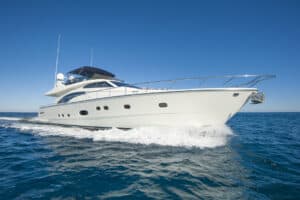
Catamaran Vs. Motor Yacht (4 Powerful Differences Explained)
The Catamaran Vs. motor yacht, a comparison that has lasted for ages, is one we will finally put to rest in this article. We promise to make spotting their differences easy. Differences Distinguishing the Catamaran Vs. Motor Yacht At the end of this section, everything that distinguishes these two sailing boats from each other will

When Boat Launches Go Horribly Wrong – A Tale Of Tragedy
I have never shared this story publically of the boat launch tragedy until now. If you are a boat owner or ever intend to be, you need to read this tragic story I’m about to share. It all began on a bright summer morning about twenty years ago. I was living in Brampton, Ontario, Canada,

Boat Information By Type
© 2023 Boating.Guide, A Hyperwave Media Group Ltd. Publication.
Privacy Overview

What Is A Catamaran Sailboat? (And What It Looks Like)

Last Updated by
Daniel Wade
August 30, 2022
Catamarans are increasingly popular for sailing and commercial use, but what sets them apart from monohulls and other multihulls?
A catamaran is a twin-hull boat with two equally-sized hulls placed side by side. They’re powered by engines, sails, or both—and they’re known for efficiency and speed. Catamarans are the most common kind of multihull boat.
In this article, we’ll go over the characteristics of catamarans and how to differentiate them from other types of boats. Additionally, we’ll cover the advantages and disadvantages of catamarans and compare them to trimarans and monohulls. We’ll also go over the most common types of catamarans and their uses.
We sourced the information in this article from marine design guides, boat identification resources, and the online boating community.
Table of contents
How to Spot a Catamaran
Spotting a catamaran is easy. Simply look at the hulls and count them. Catamarans have two hulls side by side and a relatively large gap between them where you can see light on the other end. Catamarans are distinct from trimarans, which have an additional hull between the two outer hulls.
How do Catamarans Work?
The principle behind the catamaran is simple. You can think of catamarans like cars and monohulls like motorcycles. Catamarans distribute their weight between hulls on either side, whereas monohulls utilize only one hull.
Evidently, cars are much more difficult to tip over and can hold much more weight. Additionally, cars are wider, as they have much more contact with the road. Catamarans work in a similar way, as they have a wide stance and contact with the surface on both sides.
Obviously, that isn’t the most precise comparison. But the basic principle is the same, and catamarans have a few notable benefits over monohulls.
Catamaran Vs Monohull
Catamarans are easy to distinguish from monohulls. A monohull is just a regular old boat with a single hull. The vast majority of boats and ships are monohulls. Catamarans have two hulls, which are usually sleek and narrow.
Here are some comparisons of catamarans and monohulls, along with the advantages twin-hull designs have over most single hull types.
Benefits of Catamarans
Catamarans have numerous benefits. The first is speed. Catamarans produce less drag than monohulls and thus can achieve excessive speeds both under sail and power. They don’t need to plane like monohulls to achieve these high speeds, and they use less fuel.
Catamarans are also much more stable than monohulls. They have a wide stance and shallow draft, and many waves and swells can travel between the hulls instead of below them. This effectively reduces an entire axis of movement and prevents catamarans from rolling excessively.
Drawbacks of Catamarans
Catamarans aren’t advantageous in every way, or else we wouldn’t bother building monohulls. The disadvantages of catamarans limit their use to niche commercial applications and high-end yachts. But what are the drawbacks of a twin-hull design?
Sailing catamarans don’t follow many of the traditional boat handling rules and characteristics that sailors pass down for generations. Some, such as hull speed limitations, are good to do away with—while others, such as responsiveness, are not.
Catamarans aren’t as quick to the helm or responsive as monohulls. There are some exceptions to this rule, but for the most part, you’ll get a lot more feedback from a single-hull vessel. Additionally, the large section of deck between the hulls of a catamaran is prone to pounding in rough seas, which is loud and uncomfortable.
Catamarans can sometimes be twice the width of an equivalent monohull sailboat, which can increase mooring fees and limit docking options.
The final major drawback of catamarans is a consequence of their stability. Traditional full-keel monohull sailboats have a very low center of gravity, which makes them roll in heavy seas but ensures a recovery.
Catamarans have a higher center of gravity, and they can’t right themselves after a knockdown. And though catamarans are less likely to roll, a severe list on a multihull is a much more serious concern than on a ballasted monohull.
Catamaran Vs Trimaran
Catamarans and trimarans are often lumped together, but they have very different design and performance specifications. Trimarans have three hulls, whereas catamarans have two.
Trimarans look a lot like catamarans from the side, but a quick glance at the bow or stern can set them apart. Trimarans are faster than catamarans, as they distribute their weight across three hulls instead of two. This helps them stay centered and reduces interference from pitching and rolling.
Catamarans are fast, but they lose out to trimarans when going head to head. However, catamarans are much less expensive to build and maintain and often have roomier cabins due to their larger hulls.
Types of Catamarans
There are numerous types of catamarans, and their uses vary widely. The catamaran is one of the oldest and most useful hull types, and some variants have been used for thousands of years. Here are the most common kinds of catamaran boats and their uses.
Sailing Catamaran
Sailing catamarans are probably what you think of when you hear the name. Sailing catamarans are sailboats with two identical hulls connected by a center deck. The largest sailing catamarans are spacious and stable vessels that are capable of serious offshore sailing.
Sailing catamarans have a number of notable advantages over monohulls. Monohulls, which are traditional sailboats with a single hull, are limited by a simple concept called hull speed. As the bow and stern wave of a monohull intersect, they cause drag which limits the top speed of the boat.
Catamarans are not bound by hull speed limitations, as they have two hulls. Catamarans can go twice or even three times as fast as similar monohulls and achieve excellent travel times.
Catamarans are also more stable than monohulls, as their wide stance and shallow draft reduce the effect of rough water. They don’t heel, as the force of the wind is counteracted by the double hulls. Additionally, modern sailing catamarans can ‘wave pierce’ by cutting through swells instead of riding over them.
Sailing catamarans come in many shapes and sizes. Small sailing catamarans, such as those used in races and regattas, are known for their speed and relative stability compared to light racing monohulls. Sometimes, they feature a smaller second hull for stability—these are called outriggers.
Sailing catamarans have spacious interiors thanks to the large cockpit between the hulls. This cockpit usually contains cooking and eating spaces, a place to sit, and a hallway between the hulls. The hulls usually contain living quarters and often mirror each other.
Power Catamarans
Power catamarans have an even greater variety than sailing catamarans. These vessels are used for everything from party platforms to ferries and patrol boats.
Power catamarans are a recent development, as engineers and marine architects now realize they have numerous hydrodynamic advantages over other hull types.
Catamarans are much more efficient than other hull types, as they have less drag relative to their size. Additionally, you can build a much larger catamaran with less material. This makes them popular for car and rail ferries, as builders can construct a very wide vessel with two small hulls rather than a narrower vessel with a large single hull.
Military and Commercial Catamarans
Even the military has found a use for the catamaran hull shape. The Spearhead class EPF is an expeditionary fast transport vessel designed for carrying capacity and speed. It has two sharp hulls and a huge cargo capacity.
The Spearhead class EPF is 337 feet long, which is about the same length as a WW2 escort destroyer. Yet despite having a similar length and displacement, these catamarans can travel more than twice as fast—43 knots, or nearly 50 miles per hour. Their great speed is a direct consequence of their catamaran hull type.
Power catamarans are also used as patrol and utility boats on a much smaller scale, with either outboard or inboard motors. The State of Texas uses catamarans to patrol shallow rivers and lakes. Texas Game Wardens utilize state-of-the-art aluminum catamaran patrol boats, which are fast enough to outrun most fishing boats.
There’s another form of power catamaran that you may not have considered. Pontoon boats are technically catamarans, and they’re enormously popular on lakes and rivers throughout the country. Pontoon boats aren’t known for speed, but they’re a great platform for a fun and comfortable outing.
Catamaran Houseboats
The final common type of power catamaran is the two-hulled houseboat. Houseboats don’t always use the catamaran hull type, but it’s common enough that most major manufacturers offer it as an option.
Catamaran houseboats have a few notable advantages over monohull designs. For one, they’re easier to build—especially when pontoons are chosen. Additionally, they’re better suited for navigating shallow water. These vessels can support more weight across their two hulls, offer increased stability, and they’re also efficient.
Why Aren’t Catamarans More Common?
With all the advantages listed in this article to consider, it may seem strange that the use of catamarans is still somewhat limited. At the end of the day, it comes down to economics—as monohull boats and ships are simply cheaper to build.
Additionally, catamarans have some distinct limitations. Monohulls have lots of storage space in their hulls and can carry thousands of tons of cargo safely in all weather conditions. Catamarans lack this space and low center of gravity, so they’re not ideal for transporting cargo past a certain point.
Additionally, monohulls work, and many people are reluctant to experiment with new designs when old designs work just fine. This rule applies to both large and small boats.
A large monohull sailboat can be constructed at low cost from stock plans and reliably sail almost anywhere. Very little complex structural engineering is involved, and looser tolerances reduce cost and maintenance requirements.
Related Articles
I've personally had thousands of questions about sailing and sailboats over the years. As I learn and experience sailing, and the community, I share the answers that work and make sense to me, here on Life of Sailing.
by this author
Learn About Sailboats
Most Recent

What Does "Sailing By The Lee" Mean?
October 3, 2023

The Best Sailing Schools And Programs: Reviews & Ratings
September 26, 2023
Important Legal Info
Lifeofsailing.com is a participant in the Amazon Services LLC Associates Program, an affiliate advertising program designed to provide a means for sites to earn advertising fees by advertising and linking to Amazon. This site also participates in other affiliate programs and is compensated for referring traffic and business to these companies.
Similar Posts

Affordable Sailboats You Can Build at Home
September 13, 2023

Best Small Sailboat Ornaments
September 12, 2023

Discover the Magic of Hydrofoil Sailboats
December 11, 2023
Popular Posts


Best Liveaboard Catamaran Sailboats
December 28, 2023

Can a Novice Sail Around the World?
Elizabeth O'Malley
June 15, 2022

4 Best Electric Outboard Motors

How Long Did It Take The Vikings To Sail To England?

10 Best Sailboat Brands (And Why)
December 20, 2023

7 Best Places To Liveaboard A Sailboat
Get the best sailing content.
Top Rated Posts
Lifeofsailing.com is a participant in the Amazon Services LLC Associates Program, an affiliate advertising program designed to provide a means for sites to earn advertising fees by advertising and linking to Amazon. This site also participates in other affiliate programs and is compensated for referring traffic and business to these companies. (866) 342-SAIL
© 2024 Life of Sailing Email: [email protected] Address: 11816 Inwood Rd #3024 Dallas, TX 75244 Disclaimer Privacy Policy
- More from M-W
- To save this word, you'll need to log in. Log In
Definition of catamaran
Illustration of catamaran, examples of catamaran in a sentence.
These examples are programmatically compiled from various online sources to illustrate current usage of the word 'catamaran.' Any opinions expressed in the examples do not represent those of Merriam-Webster or its editors. Send us feedback about these examples.
Word History
Tamil kaṭṭumaram , from kaṭṭu to tie + maram tree, wood
1673, in the meaning defined above
Dictionary Entries Near catamaran
Cite this entry.
“Catamaran.” Merriam-Webster.com Dictionary , Merriam-Webster, https://www.merriam-webster.com/dictionary/catamaran. Accessed 29 Aug. 2024.
Kids Definition
Kids definition of catamaran, more from merriam-webster on catamaran.
Thesaurus: All synonyms and antonyms for catamaran
Nglish: Translation of catamaran for Spanish Speakers
Britannica.com: Encyclopedia article about catamaran
Subscribe to America's largest dictionary and get thousands more definitions and advanced search—ad free!

Can you solve 4 words at once?
Word of the day.
See Definitions and Examples »
Get Word of the Day daily email!
Popular in Grammar & Usage
Plural and possessive names: a guide, 31 useful rhetorical devices, more commonly misspelled words, why does english have so many silent letters, your vs. you're: how to use them correctly, popular in wordplay, 8 words for lesser-known musical instruments, it's a scorcher words for the summer heat, 7 shakespearean insults to make life more interesting, birds say the darndest things, 10 words from taylor swift songs (merriam's version), games & quizzes.

- Yacht Charter
- Yacht Experiences
- My Boataffair
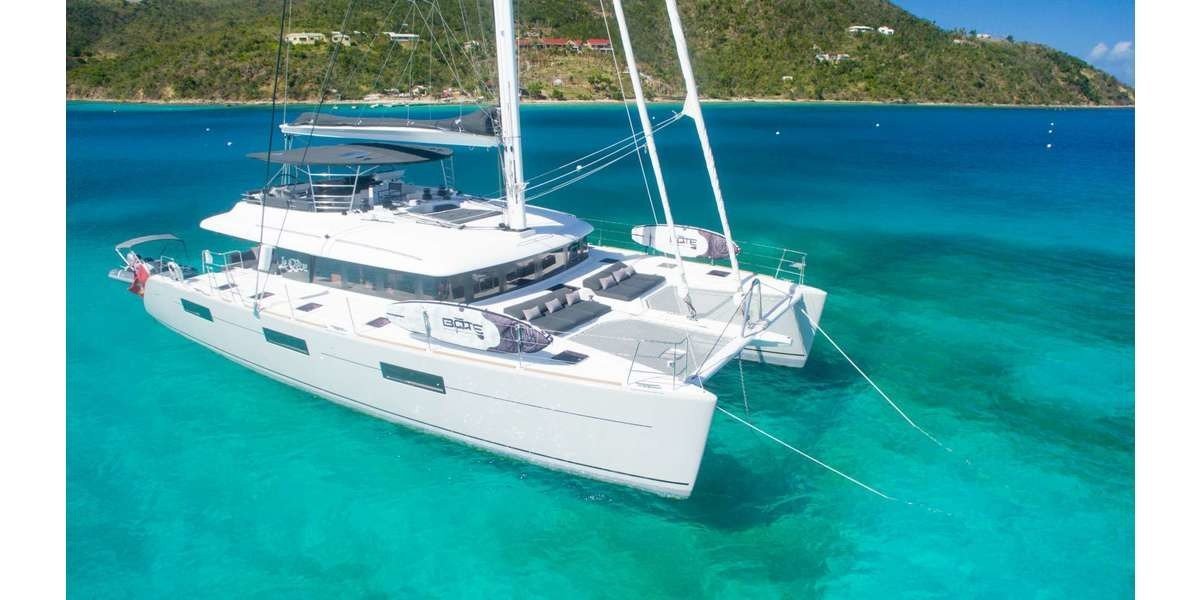
What Is a Catamaran?
If you’re thinking of chartering a catamaran on your next trip, read through our guide and get up to speed on two hulled yachts! We offer Catamarans for charter in over 60 countries and the entire selection can be seen on our Catamaran charter page.
A Catamaran is a sail or engine-powered boat with a double hull, a distinct feature that makes it immediately recognizable once you're aware of the design. People often question whether a catamaran is a yacht, and due to the sleek style, versatility, speed capabilities, and comfort, a catamaran definitely earns the yacht stamp of approval. Due to these same characteristics, catamarans are becoming an increasingly popular choice among avid leisure and sport sailors.
The elegant and unique catamaran style isn't a new development - it's actually a centuries-old design that's been modified and built upon to become what it is today.
The first Catamaran was created in India, borrowing its modern name from the original Tamil word kattumaram, meaning "logs bound together". The first design was simply a raft made of tree trunks, built in the fishing communities of Tamil Nadu in southern India and used to invade several Southeast Asian countries as early as the 5th century. The kattumaram quickly became the favoured vessel style throughout Polynesia and Micronesia.
Evolved by American Nathanael Herreshoff in the 1870s and further developed in the 1950s, the catamaran concept really took off in the 20th century. It was soon functioning as a full-fledged yacht, able to compete in the racing arena with mono-hulled boats without compromising luxury. Nowadays, catamarans attract both sport and leisure boaters with its versatility, speed, and comfort.
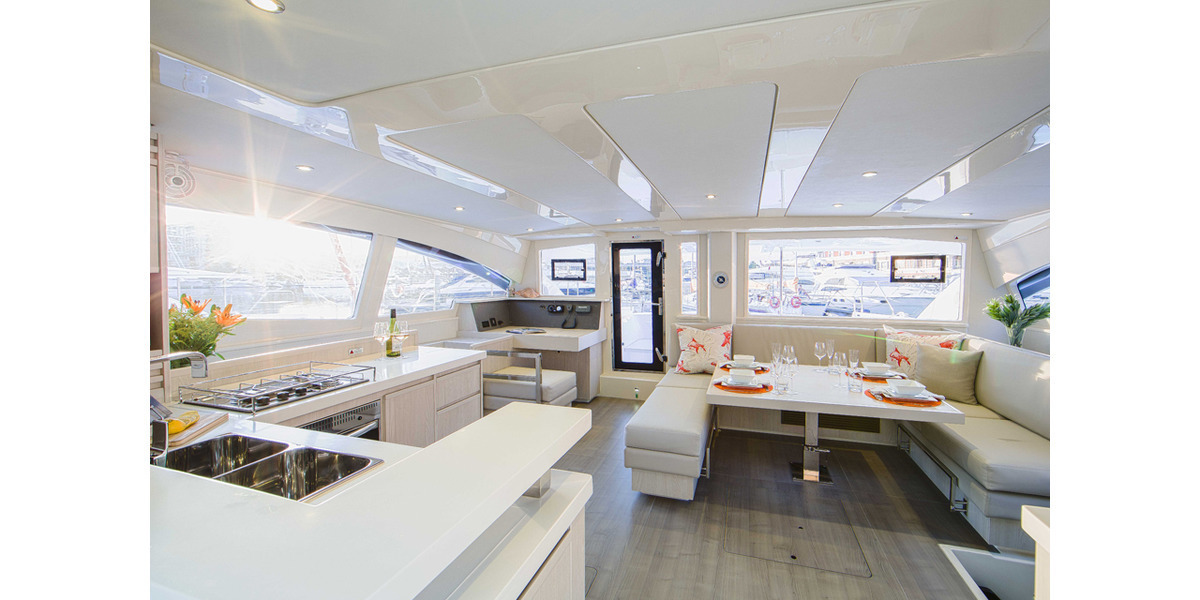
What are the Characteristics of a Catamaran Hull?
The most obvious characteristic of a catamaran is the twin hull, but there are more benefits to the cleverly crafted underside. When compared to a monohull yacht of the same size, the catamaran hull has several big advantages. Catamaran hulls are noted for having less volume, lighter displacement, and shallower draft (ie less of the boat is below water) when compared to monohull vessels. The shallow draft is especially appealing, allowing for use in shallow water and giving the captain the option to pull the boat right up to shore without worry.
Additionally, because of the hull design, catamarans boast a smaller hydrodynamic resistance, ultimately making them more economic since they don't need as much fuel to propel them forward. And for those sailors still strengthening their sea legs, the double hull increases the catamaran's overall balance and stability by reducing the amount of wave-induced motion. So long seasickness!
Catamarans have a lot of space. The living area in between the two hulls offers a dining and lounging area as well as a spacious kitchen. You also find outside lounging areas at the back and in the front of the yacht. The various places to relax mean a lot of privacy on board. The two hulls further increase the privacy aspect because the cabins are separated by the central living area and each hull has their separate entrance in most cases. This makes the Catamaran the ideal yacht to charter for two couples, two families, a group of friends or a large family. The cabins in the hulls are spacious and comfortable and their sizes vary with the exact Catamaran model.
So in summary, catamarans:
- have two hulls, usually connected by a bridgedeck
- can be sailed in shallow water
- use less fuel, because they have low hydrodynamic resistance
- tend to be very stable
- have a lot of space for dining and lounging and preparing food
- offer greater privacy than monohull yachts
To give you an idea of the space and amenities on board a Catamaran, do have a look at the many pictures of our Fountain Pajot Alegria 67 for charter in the British Virgin Islands .
How to Sail a Catamaran
You're sold on the idea of a catamaran, but now comes the question, how hard is it to sail a catamaran? Learning how to sail a catamaran is relatively straight forward if you're already trained in the basics of sailing. Although it does differ from monohull vessels, the idea is the same. Be prepared to tweak your sail trimming skills and get used to the difference in motion (or lack thereof) with the catamaran.
The catamaran is gaining popularity because the better-balanced hull and twin engines make it arguably easier to operate than a monohull yacht. Fluid maneuverability means that even one person can sail a catamaran as long as they've built up enough sail experience. Still, it's never a bad idea to get some formal training; the ASA and RYA both offer catamaran sailing courses to help enhance your skills.
How Fast Can a Catamaran Sail?
Catamaran's can cruise! Their speed is just another reason why the boat has become so sought-after in recent years. A sailing catamaran can typically perform 25% - 30% faster than a monohull of the same size.
So just how fast can they go? Cats average about 10 knots with top speeds reaching around 15 knots. Just keep your weight in mind - catamarans respond sensitively to heavy loads and will perform slower if overweight.

Why Charter a Catamaran?
When compared to a monohull boat of the same size, a catamaran has a tendency to be a bit more expensive to charter. However, your trip itinerary might require certain criteria that make spending a bit more worth it. For example, the flat plane and stability of a catamaran are ideally suited for a family to enjoy their holidays in a lot of comfort. It is also ideal for a scuba diving holiday , allowing divers to gear up and enter/exit the water with ease. Additionally, big parties usually find catamarans better suited for their needs in terms of deck space and overall comfort.
A Catamaran is the ideal yacht for a relaxing vacation as it boasts a lot of space, stability and living spaces - it truly is your floating hotel. But note that a catamaran holiday does not need to break the bank and is very affordable in comparison to a vacation in a hotel or a villa depending on the type and size of a catamaran you decide to go for.
***************************
Catamarans are a fun alternative to the traditional sailing yacht and the value for money is unrivalled for a yacht holiay. They provide comfort, flexibility and a lot of space to spend your time on the sea. You can also check out this Comprehensive guide to chartering a yacht for more information.
Curious? Check out Boataffair's huge choice of catamarans to charter in the world's most sought after destinations.
- Frequently asked questions
- Yachts for Charter
- Experiences
- E-Gift cerificates
- Browse yachts by type
- Terms of Use
- Privacy Policy
- Terms of Use E-Gift Card
- Boataffair AG
- Schuetzenstrasse 43
- 5454 Bellikon
- Switzerland
- Send a message
- [email protected]
- +41 78 612 29 19
- Rating: 5.0 / 5.0 Average from 180 reviews
- See our customer reviews

What Is A Catamaran? Does It Have Engines Or Can It Only Sail?

Catamarans are a type of boat that has two hulls connected by a platform. They offer many advantages over traditional monohull boats, including increased stability and improved speed. This article will explore what exactly catamarans are and how they can be powered. We’ll also look at the differences between sailing and motor-powered catamarans to help you decide which one is right for you.
What Is A Catamaran?
A catamaran is a type of boat with two hulls connected by beams. It is usually powered by sails, although all modern catamarans come with inboard motors for propulsion. Catamarans are traditionally used for sailing, fishing, and leisure activities . They can be used in both fresh and salt water, and their light weight allows them to travel at high speeds without using much fuel.
Catamarans are known for their stability and durability due to their wide beam and shallow draft. This makes them ideal for traversing shallow waters or areas where the sea is choppy and unpredictable. They also have the advantage of being able to turn quickly and maneuver easily in tight spaces. Additionally, they provide a smooth ride despite rough seas since the two hulls help to reduce wave impact on the boat itself.
Advantages Of Catamarans
Catamarans offer many advantages to sailors and other seafaring travelers. The primary benefit of catamarans is their stability, due to the fact that they have two hulls that are connected by a platform. This design makes them much more resistant to waves than monohull vessels, which makes them ideal for activities such as fishing or leisurely cruises near shore. Catamarans also tend to be lighter, faster and more fuel efficient than monohulls, making them an attractive choice for sportier outings such as racing or overnight trips. In addition, catamarans can either be powered by engines or sails, giving you the flexibility to choose whatever type of propulsion suits your needs best.
Types Of Catamarans
Catamarans come in a variety of shapes and sizes, from luxurious yachts to fast-moving racing boats. They offer a unique sailing experience, with their twin hulls providing stability and comfort while still able to reach high speeds. Catamarans can be powered by engines or sail, enabling them to move swiftly through the water. Some are designed for serious racing, while others are equipped for leisurely cruising on the open waters. With so many options available, there is sure to be a catamaran that will fit any sailor’s needs. Whether it’s speed or comfort that you’re after, a catamaran can provide an unforgettable experience on the seas.
Sailing Vs. Motor-Powered Catamarans
Catamarans offer many advantages over monohulls and have become a popular choice for many reasons.. They are lightweight, stable, and provide ample space onboard. However, there is one major decision to make when purchasing a catamaran: whether to choose a sailing or motor-powered version.
Sailing catamarans have the traditional look of a boat with two hulls and tall sails, while motor-powered catamarans come equipped with engines and resemble more of a powerboat. Both types of catamarans offer their own unique benefits and drawbacks. Sailing versions are cheaper to purchase but require the sailor to be knowledgeable in sailing tactics in order to navigate easily. Motor-powered versions are more expensive but can be easier to operate in certain conditions due to their greater speed and maneuverability. In the end, it comes down to personal preference as both types can provide an enjoyable experience on the water.
Benefits Of Chartering A Catamaran
Catamarans are a type of sailing vessel with two hulls that are connected with a frame. They are typically very stable and have plenty of deck space for passengers and amenities. Catamarans also come equipped with two engines, so they can travel in calm waters even when there’s no wind to power the sails. The engine also allows them to get back quickly against strong winds or tides, making them great for long trips and passages.
The major benefit of chartering a catamaran is the amount of space it provides compared to traditional monohulls (a boat with one hull). This makes them ideal for larger groups, as they can accommodate more people without feeling cramped. Additionally, catamarans offer great stability in the water – even in choppy conditions – allowing you to feel safe and secure while onboard. Plus, since they don’t require as much maintenance as other boats, they’re perfect for longer periods of time on the water. All these factors make catamarans a great choice for any travel vacation with friends and family.
Frequently Asked Questions
Are catamarans suitable for excursions.
Catamarans are a popular choice for those looking to charter one for an excursion due to their spaciousness and stability. They provide more than enough room for comfortable traveling as well as plenty of storage space, making them an ideal option for extended cruising. Additionally, all catamarans are equipped with engines, allowing for easy navigation and maneuverability when needed. All in all, catamarans make great vessels for vacations and traveling and can be a great way to explore the waters.
What Is The Best Type Of Catamaran For Ocean Voyaging?
When it comes to ocean voyaging, the best type of catamaran is a modern performance cruiser. These vessels are designed to combine speed and comfort, with a shallow draft for navigating in and out of shallow waters. Modern performance cruising catamarans feature two hulls connected by an open deck, often with engines that give them greater maneuverability. They also generally have larger living spaces than traditional monohulls, so they can provide more comfortable accommodations during long voyages.
How Many People Can Typically Fit On A Catamaran?
A catamaran is a type of boat with two parallel hulls. Depending on the size, it can typically fit anywhere from 4-12 people plus crew. It’s important to note that the number of passengers will depend on the size and design of the boat, so it’s best to check with a manufacturer for more specific details.
A catamaran is a great choice for those looking to explore the ocean in style. They’re spacious and versatile, making them suitable for all sorts of travel plans and excursions. Plus, they can be powered by either engines and/or sails, so you can decide which works best for your needs. Charter prices can vary depending on your vacation needs. All in all, a catamaran is an excellent choice for anyone wanting to explore the open seas!
If you’re considering renting a catamaran, it’s important to do some research first. There are many different kinds to choose from depending on what your entire party has on their travel wish list – and make sure that you have a safe and fun voyage!
Get a Quote
Are you ready to let us show you what we can do for you? We can’t wait! This is as exciting for us as it is for you. We began this business because we love putting the perfect yacht charter together for our clients and getting the best of the best at the right price point thanks to our contacts and experience.
Use our quick contact form to give us the basics about what you’re looking for and we’ll send you ideas and pricing. Don’t worry if it’s not grand enough or should be scaled back; we’ll take care of that too. When you love the plan, we put it into action. All you have to do is show up and enjoy.
More Vacation Tips
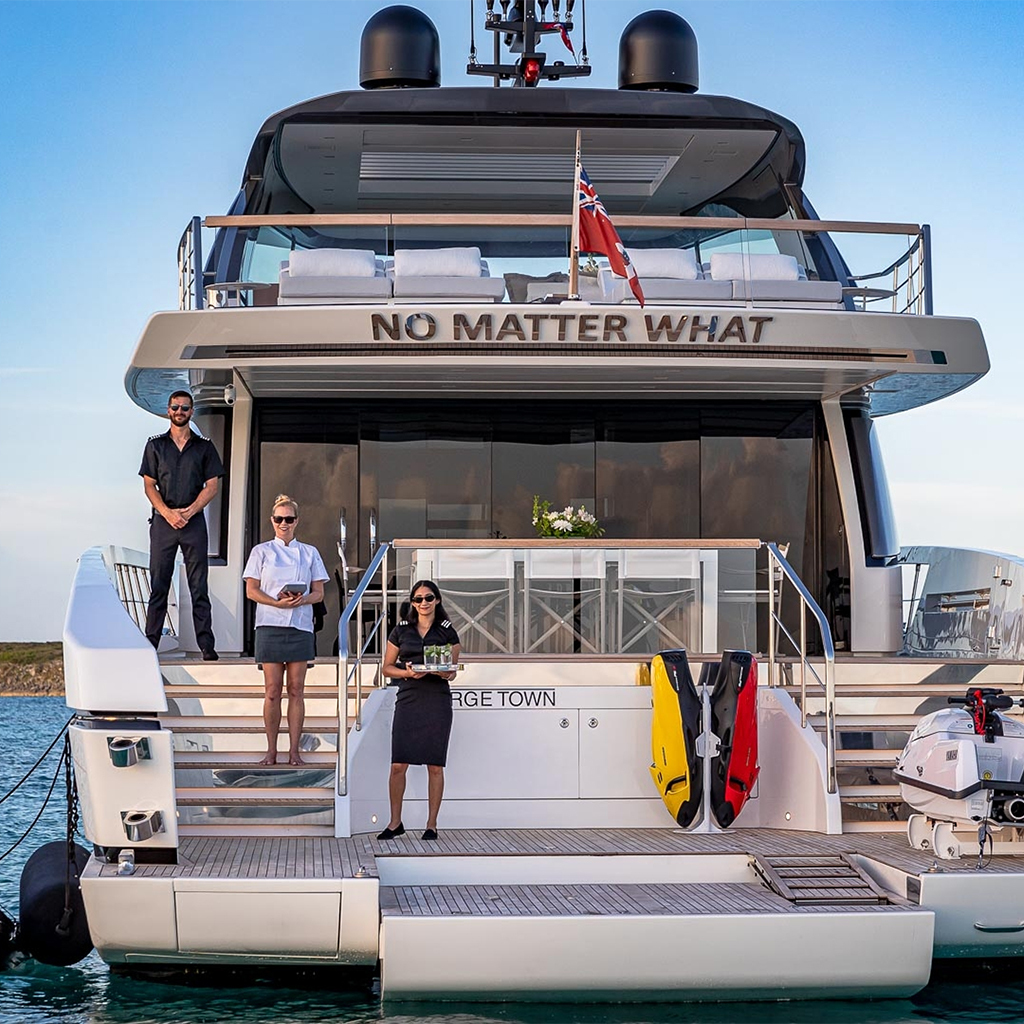
Why Canvas Yacht Charters is the Ultimate Way to Explore the Virgin Islands

Vacation Better with Canvas Yacht Charters: Unlock the Ultimate Yachting Experience
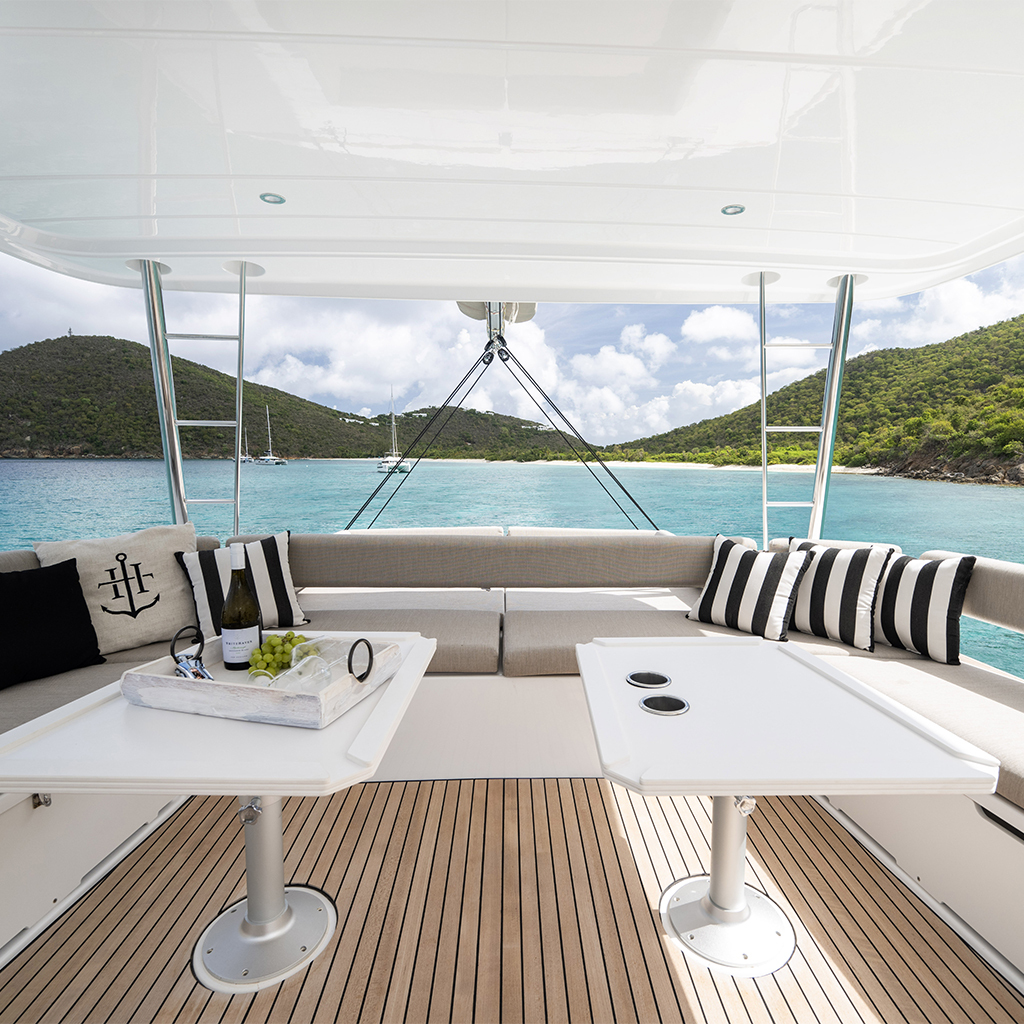
Top 5 Reasons to Choose a Yacht Charter in the Virgin Islands for Your Next Vacation

What Does Catamaran Mean? (Unraveling the Mystery)
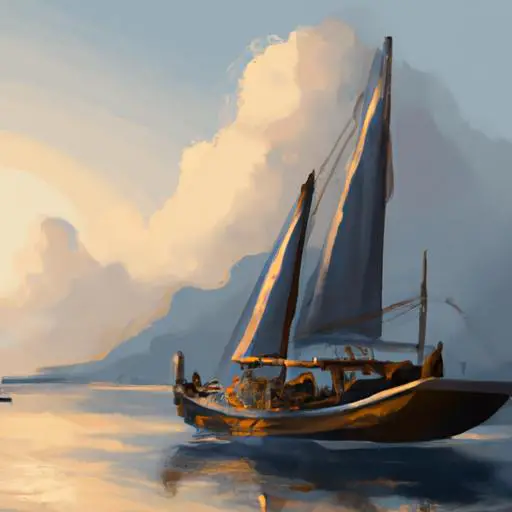
Have you ever wondered what it is about catamarans that make them so special? From their fascinating history and construction to their various uses and advantages, catamarans have been captivating sailors and adventurers around the world for centuries.
In this article, we’ll unravel the mystery of the catamaran – from its origins to its modern-day uses – and discuss the differences between sailing a catamaran and a monohull.
Journey with us as we explore the history, construction, advantages, and uses of catamarans, as well as the exciting world of catamaran racing.
Come and discover the allure of the catamaran and the possibilities that lie ahead for the future of this remarkable vessel.
Table of Contents
Short Answer
A catamaran is a type of sailboat or motorboat that has two parallel hulls of equal size.
It is a type of multihull boat, and its stability and shallow draft make it a popular choice for recreational sailing.
Catamarans are also used as ferries, charter boats, and racing boats, and they are known for their fast speeds and maneuverability.
History of Catamarans
The history of catamarans can be traced back thousands of years to ancient seafaring cultures.
The earliest known recorded usage of the term catamaran dates back to 17th century Tamil sailors of the Coromandel Coast in India.
The term catamaran is derived from the Tamil word kattumaram which means tied wood.
This name was given as the boats were made from two wooden hulls connected together with rope or wooden beams.
Catamarans were used by the Polynesians for exploration and travel, as well as for fishing and trading goods.
In the 19th century, the British Navy began to use catamarans in the Indian Ocean, and by the end of the 19th century, catamarans had been adopted by many cultures around the world.
Today, catamarans have become popular vessels for recreational activities.
They are often used for sailing, fishing, pleasure cruising, and racing.
The stability and speed of catamarans make them an ideal choice for these activities.
They are also easy to maneuver and can be powered by either sails or engines.
Catamarans are also used for commercial purposes such as ferrying passengers and goods, and for research and exploration.
They are ideal for shallow areas due to their shallow draft, which makes it easier for them to navigate in shallow waters.
The popularity of catamarans has grown in recent years due to their versatility and stability.
As the demand for catamarans continues to increase, so does the variety of designs and features available.
This makes catamarans an attractive and popular choice for all types of seafarers.
How Are Catamarans Constructed?

Catamarans are typically constructed out of wood, fiberglass, or aluminum.
Wood is the most traditional material used, and is still widely used today for catamarans that are primarily used for recreational purposes.
Fiberglass is often used for catamarans that are used in racing, as it is lightweight and strong, and can be molded to create a sleek and streamlined hull.
Aluminum is an increasingly popular choice for catamarans, as it is lightweight, durable, and corrosion-resistant.
The hulls of catamarans are typically connected by a framework of beams and stringers that provide stability and strength.
The bridge deck, which is the part of the catamaran that connects the two hulls, is usually reinforced with aluminum or carbon fiber for added strength.
The bridge deck also typically has additional features such as seating, storage, and a helm.
The mast, which is used to support and control the sails, is typically made of aluminum or carbon fiber.
Catamarans also typically feature a large cockpit, which is the area where the crew sits and operates the boat.
The cockpit is typically equipped with a helm, controls, and seating.
The cockpit may also feature an aft platform, which is an area that can be used for fishing, swimming, or lounging.
Catamarans are also typically equipped with a variety of safety and navigational equipment.
This can include navigation lights, life jackets, flares, a compass, and a GPS.
In addition, catamarans may also be equipped with a radio, VHF, depth sounder, and autopilot.
Catamarans are a great choice for sailing and recreational activities due to their stability and speed.
With the right construction and equipment, catamarans can be a safe and enjoyable boat for a variety of activities.
Advantages of Catamarans
Catamarans offer a unique experience and provide some advantages that other boats do not.
Catamarans are known for their stability, speed, and maneuverability, making them a great choice for sailing and recreational activities.
The two parallel hulls of equal size provide a wider platform which increases stability and helps to reduce rocking and pitching, making them a great choice for fishing and pleasure cruising.
Catamarans are typically powered by both sails and engines, which allows them to reach high speeds and make sharp turns.
This is great for racing, as the two hulls provide a low drag coefficient which allows for increased speed and maneuverability.
Catamarans are also known for their shallow draft and wide beam, which makes them great for navigating through shallow waters.
This makes them a great choice for exploring narrow coves and coastline.
The wide beam also creates more room for activities and amenities, such as fishing chairs, lounging areas, and other recreational activities.
This makes catamarans a great choice for entertaining and hosting family and friends on the water.
Overall, catamarans provide an experience unlike any other type of boat.
With their stability, speed, maneuverability, and room for activities, catamarans make a great choice for sailing and recreational activities.
Catamaran Uses

Catamarans have become increasingly popular in recent years due to their stability, speed, and versatility.
Catamarans are often used for a variety of purposes, including fishing, pleasure cruising, racing, and even military operations.
Catamarans offer an incredibly stable ride, making them ideal for recreational activities such as sightseeing, snorkeling, and swimming.
The two hulls provide plenty of space for comfortable seating and storage, and they also offer a large deck area for sunbathing or barbecuing.
Catamarans are also incredibly fuel efficient , so they are great for long trips or extended charters.
Additionally, they are incredibly fast and maneuverable, making them ideal for racing or long-distance voyages.
Catamarans are also incredibly versatile, as they can be easily adapted to meet a variety of needs.
From luxurious pleasure cruisers to rugged fishing vessels, catamarans come in all shapes and sizes to suit a variety of needs.
Catamaran Sailing vs. Monohull Sailing
When it comes to sailing, catamarans and monohulls are two of the most popular options.
Both offer unique benefits and drawbacks that sailors must consider when deciding which type of boat is best for them.
One of the most noticeable differences between the two is the stability.
Catamarans are much more stable than monohulls, making them ideal for recreational activities like fishing and pleasure cruising.
This is because catamarans have two parallel hulls that provide a wider platform for support, which helps to reduce the risk of capsizing.
Additionally, catamarans are lighter and can reach higher speeds than monohulls, making them great for racing.
When it comes to sailing, monohulls are also a popular choice.
They are less stable than catamarans, but they are much more maneuverable.
Additionally, they are more efficient when it comes to sailing upwind, making them a great choice for longer voyages.
Monohulls are also much lighter than catamarans, making them easier to tow and store.
When it comes to cost, both catamarans and monohulls can be quite expensive.
Catamarans tend to be more expensive due to their larger size and need for more materials.
However, monohulls are typically less expensive to maintain, making them a better option for those on a tighter budget.
In conclusion, both catamarans and monohulls offer unique benefits and drawbacks that sailors must consider when choosing the right boat for them.
Catamarans are more stable, faster, and better suited for recreational activities, while monohulls are more maneuverable, lighter, and more efficient when it comes to sailing upwind.
Ultimately, the decision between the two types of boats will depend on the individuals needs and preferences.
Catamaran Racing

Catamaran racing is an exciting and thrilling way to experience the power of a catamaran.
It is an exhilarating sport that is becoming increasingly popular due to its speed and agility.
Catamaran racing is a great way to enjoy the open water and connect with nature in a unique way.
Catamaran racing is a test of skill, agility, and endurance.
Racers must possess excellent boat handling skills, tactical awareness, and an understanding of the wind and weather conditions.
Catamaran racing requires an immense amount of physical strength, as racers must be able to maneuver their boats quickly and accurately.
Catamaran racing is a team sport, as there are typically two to four crew members onboard.
Each crew member has an important role in the success of the race, from setting the sails to navigation.
Every crew member must be in sync and communicate effectively to ensure a successful race.
Catamaran racing can be both a recreational and competitive activity.
Recreational racers can enjoy the thrill of racing without the pressure of competition, while competitive racers must be able to control their emotions and make sound decisions.
Overall, catamaran racing is an exciting and thrilling way to experience the power of a catamaran.
It is a great way to enjoy the open water and connect with nature in a unique way.
Whether you are a recreational or competitive racer, catamaran racing will provide you with an unforgettable experience.
The Future of Catamarans
The future of catamarans is bright, with more and more people discovering the joy of sailing and recreational activities on a catamaran.
Catamarans are increasingly being used for fishing expeditions, pleasure cruising, and even racing.
The design of a catamaran makes it highly maneuverable and stable in the water, making them an excellent choice for a variety of sea-based activities.
With advancements in technology, catamarans are becoming even more user-friendly and efficient.
Innovative designs, such as the addition of hydrofoils, are making catamarans faster and more enjoyable to ride.
Additionally, the use of composite materials and other new engineering techniques are making catamarans lighter and more resistant to corrosion.
The popularity of catamarans is also growing due to their ability to accommodate larger groups and more activities.
With plenty of space for seating and storage, catamarans can be used for entertaining, family trips, and even corporate events.
In addition, many modern catamarans have amenities such as showers, bathrooms, and kitchens, making them more suitable for longer voyages.
The future of catamarans looks bright, with more people discovering the joy of sailing and recreational activities.
With new innovations and improvements, catamarans are becoming more user-friendly and efficient, making them a great choice for a variety of sea-based activities.
Final Thoughts
Catamarans have been around for centuries and have become increasingly popular for recreational and racing activities due to their stability, speed, and efficiency.
With a combination of sails and/or engines, catamarans can be used for fishing, pleasure cruising, and racing.
The term “catamaran” comes from the Tamil word “kattumaram” which means “tied wood”.
Whether you’re looking for something to take out on the lake for a day of pleasure cruising or to compete in a catamaran racing event, there’s no doubt that catamarans are an incredible way to experience the water.
So why not give it a try and see what catamaran sailing is really all about!
James Frami
At the age of 15, he and four other friends from his neighborhood constructed their first boat. He has been sailing for almost 30 years and has a wealth of knowledge that he wants to share with others.
Recent Posts
When Was Banana Boat Song Released? (HISTORICAL INSIGHTS)
The "Banana Boat Song" was released in 1956 by Harry Belafonte. This calypso-style song, also known as "Day-O," became a huge hit and remains popular to this day for its catchy tune and upbeat...
How to Make Banana Boat Smoothie King? (DELICIOUS RECIPE REVEALED)
To make a Banana Boat Smoothie King smoothie at home, start by gathering the ingredients: a ripe banana, peanut butter, chocolate protein powder, almond milk, and ice. Blend the banana, a scoop of...

What Is a Catamaran? Things You Need to Know
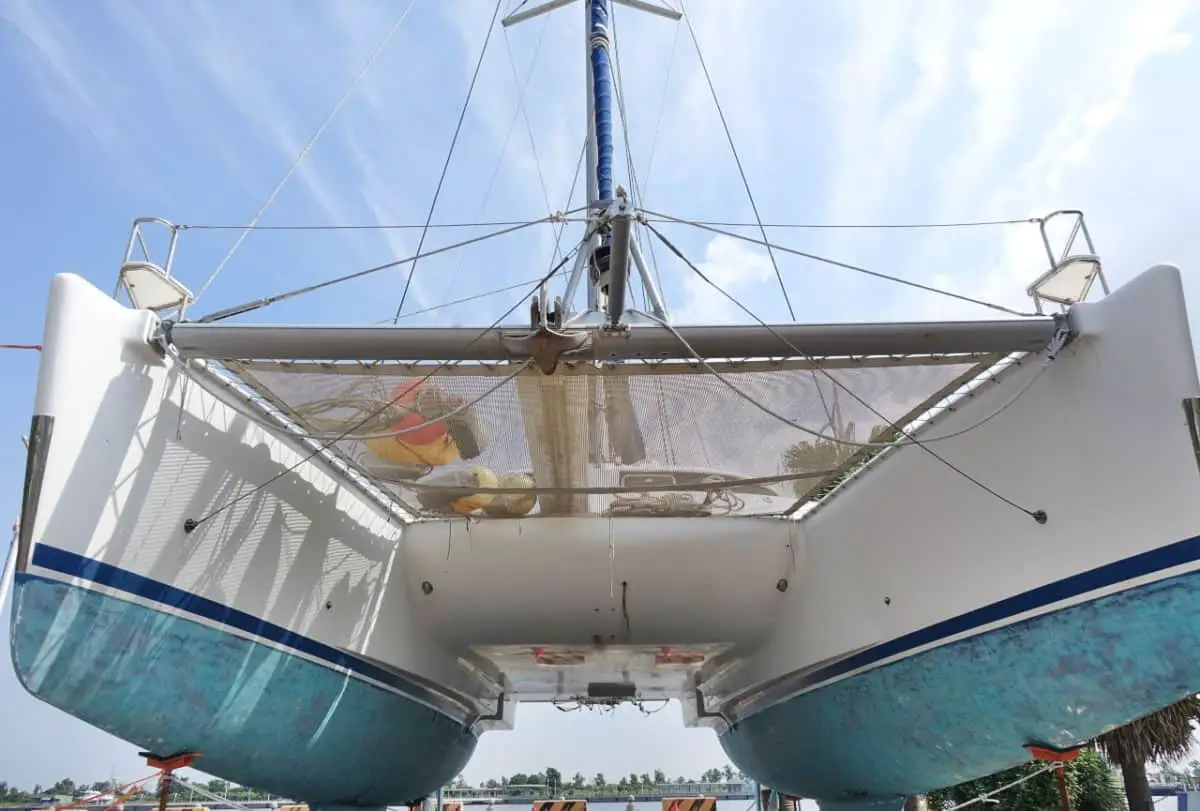
As an Amazon Associate, we earn from qualifying purchases. We may also earn commissions if you purchase products from other retailers after clicking on a link from our site.
Whether you’re a sailing enthusiast or have recently adopted an interest in yachts, you’ve probably heard of catamarans. It can be confusing as the term seems to describe boats, ships, and even massive-cruise vessels. So, what is a catamaran?
A catamaran is a boat with two hulls and a bridge between them. Catamarans can be designed as sailboats or motorboats. A catamaran stays stable since it has a wide base, it does not have a deep keel as on a monohull . Cats are known for not heeling, increased comfort, more space, and faster speeds.
In this article, we will explore everything you need to know about this design, including its origin and its advantages.
Table of Contents
Catamaran: A Basic Overview
The term catamaran comes from a 17th-century Tamil term kaṭṭumaram . The Tamil word stands for “tied wood,” but those vessels do not share the same working principle as catamarans.
Even though most “tied wood” rafts in the 17th century India used two logs to keep the deck afloat, the logs acted more like pontoons than catamaran hulls. However, the commonality of two logs translated to catamarans, as these vessels generally have two hulls.

Since the term refers to the design, it is correct to refer to any vessel with two hulls connected by a bridge as a catamaran. However, technical accuracy doesn’t necessarily mean general-use correctness. While cruise ships can have catamaran design and small rafts may feature two hulls, the term is most often used for yacht-sized cruising sailboats.
Buyers who would not previously afford any vessel close to a mid-sized yacht can easily order a brand-new catamaran. Even investors interested in collecting income from catamaran renting opt for medium scale catamarans to hedge against depreciation and damage. Therefore, the term catamaran has become synonymous with medium-scale yachts with two hulls.
For the rest of this article, we’ll use the term to reflect these vessels, and if a catamaran-style cruise-ship or smaller boats are brought up, the distinction will be highlighted. It is also worth noting that even when dealing with manufacturers and industry literature, the word will refer to medium-sized yachts unless specifically differentiated.
What Are Catamarans Made Of?
One of the most interesting subjects in the overall catamaran conversation is the materials used to manufacture these vessels. That’s because different brands use different technology to compose the materials required for the hulls and other areas of a catamaran.
Hulls of a Bali catamaran are built with sandwich infusion technology using polyester and closed-cell PVC. The brand’s catamarans are fitted with daggerboards, and material variety includes Kevlar in regions of impact and carbon fiber in the lower-weight areas.

Lagoon catamarans have a history of using solid glass below water level , but newer models have a balsa core in the submerged region . While the specifics of composting technology and materials may vary from brand to brand or even model to model within the same brand, the fact that most of these vessels are made of composite material remains consistent.
Parts of a Catamaran
One cannot ask what a catamaran is without getting curious about the various parts of such a vessel. Here is a breakdown of the various parts that go into this vell’s construction:
Unlike monohulls, a catamaran has two of these. They’re usually hollow and fitted out with beds and even a glass window to look out into the water since they’re not submerged. The hulls’ function is to push down on the water, so the water reacts by pushing the vessel up. Therefore, they play an essential role in the catamaran’s buoyancy.
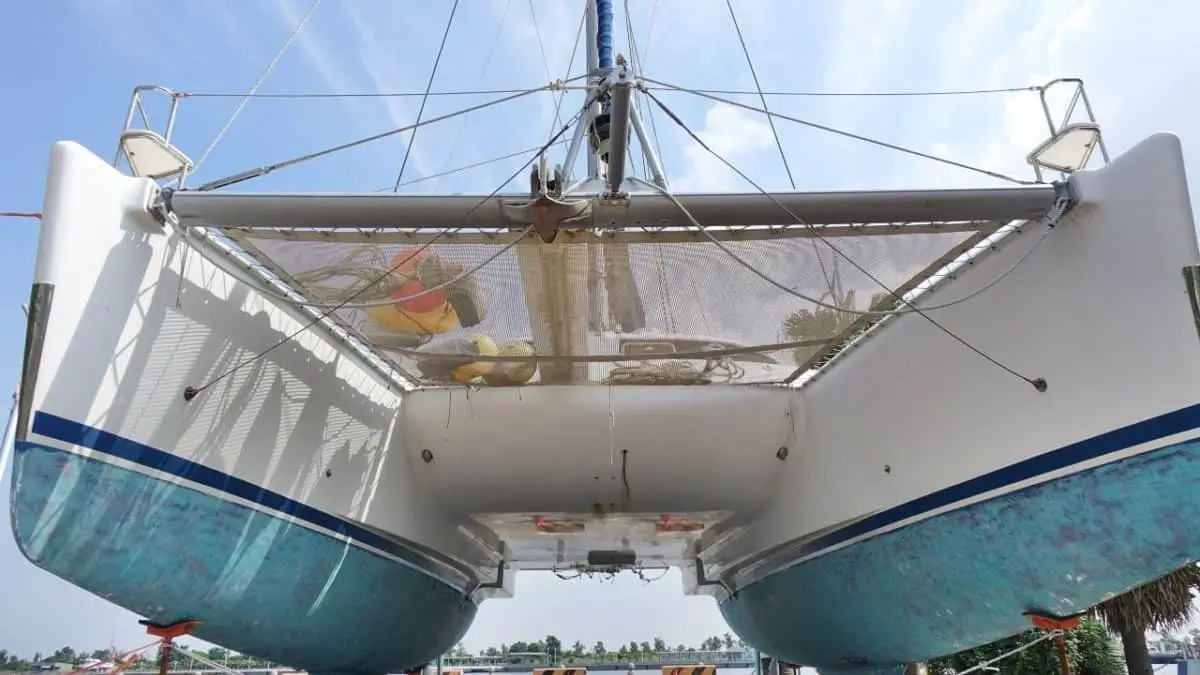
Cross Beams
Because the hulls exert force on the water, there needs to be something that ensures the water’s reaction (upwards force) doesn’t break the deck. Crossbeams serve as connectors between the two hulls and hold them together such that water’s upward force is distributed evenly across the surface between the hulls.
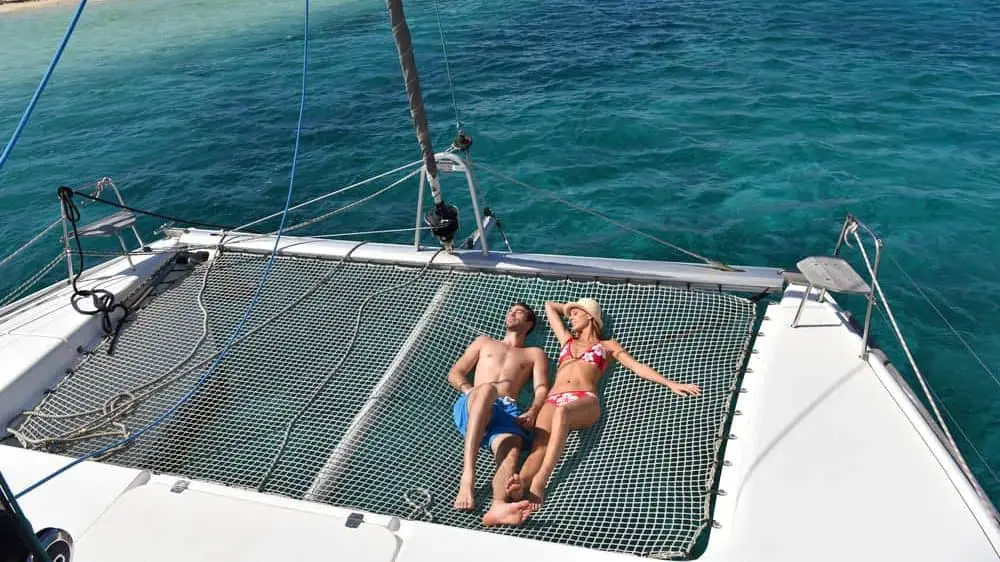
Depending on the size of the vessel, the number of cross beams may vary. Some of the critical characteristics of cross beams include high density and low surface area.
A bridgedeck, as the name suggests, is a deck that serves as a bridge between the hulls. Manufacturers make a compromise between space and sailing efficiency when deciding how to design a bridgedeck for their catamarans. A bridgedeck is given significant clearance to allow for smooth sailing but not too much to leave behind, only the deck for living space.
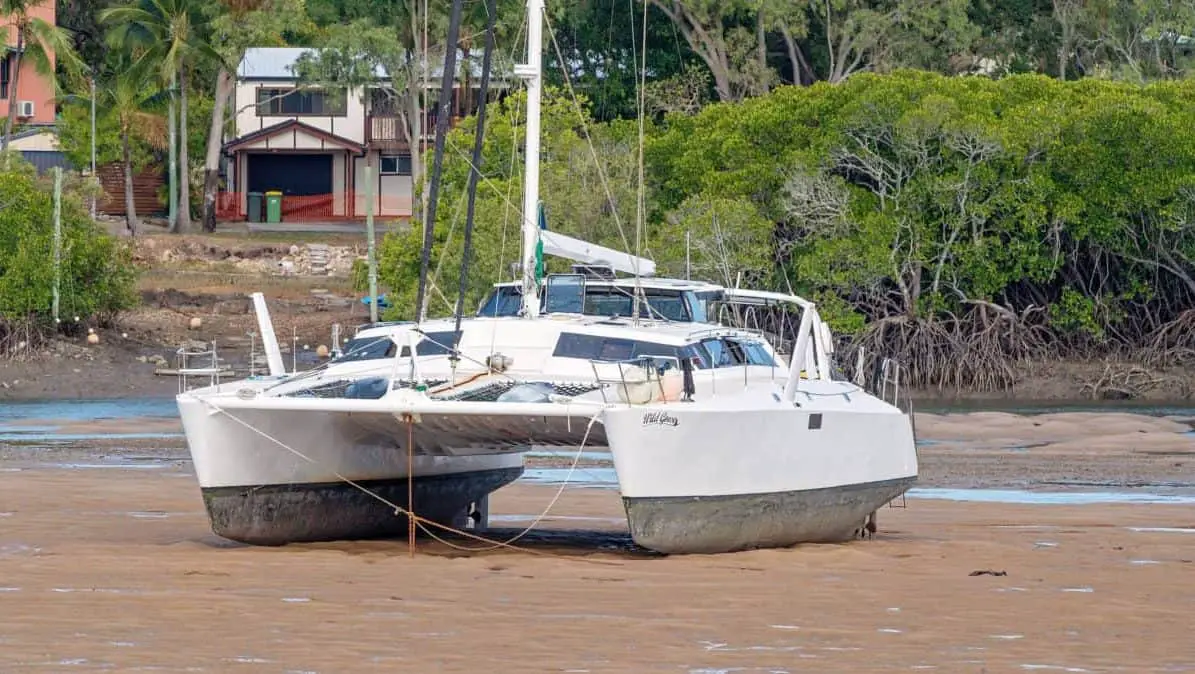
What you should keep in mind about a bridgedeck is that the smaller its clearance, the more water hits its bottom, causing discomfort for those sailing and dealing damage to the vessel. Also, you can’t minimize the bridgedeck without affecting the hull size, which means you have to compromise between the two.
Bridge deck slamming explained
Other Parts
While the aforementioned parts are key to a catamaran’s construction, they are by no means an exhaustive list of every vessel’s component.
Catamarans have a topdeck, oftentimes a saloon, and separate chambers depending on the size. The standard vessel will have the interior fitting of a yacht of a similar size. Since none of these parts are specific to catamarans, a detailed breakdown of each isn’t necessary.
Catamaran parts explained
How Long Does a Catamaran Last?
Since catamarans aren’t impulse-buys, you must consider the longevity of the specific model you wish to buy. If you go with a boutique manufacturer without knowing about materials and construction, you may be sold a vessel that may last only seven years.
On the other hand, brands that list their construction methods with transparency regarding materials used are more confident in their product, which has five times the longevity of a cheaply manufactured catamaran.
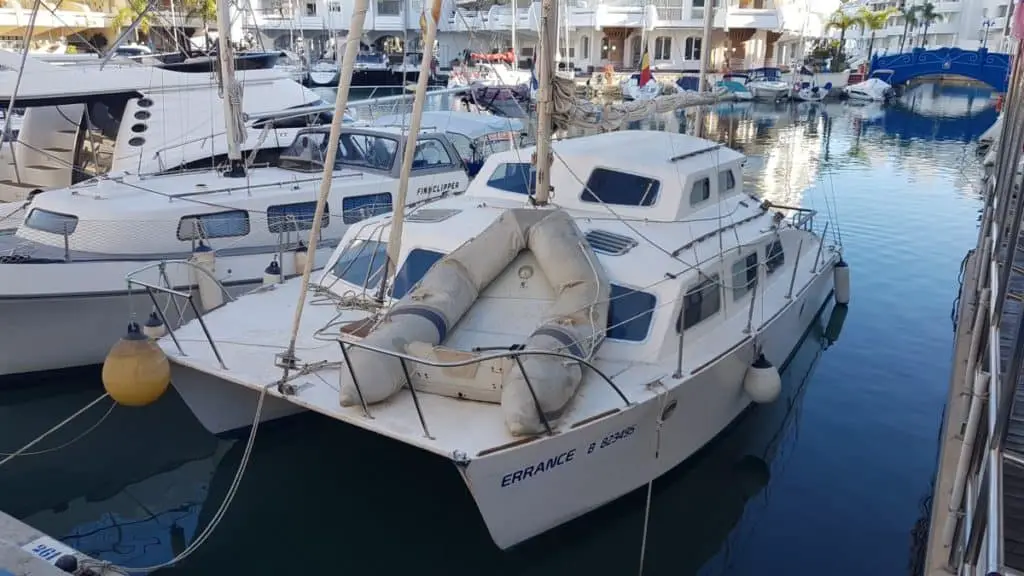
Suppose you wish to purchase a catamaran you want to have for 15+ years. In that case, you may avoid buying a “performance” catamaran that focuses on lightweight in favor of sailing speed and effortlessness on the waves. This conversation becomes more complicated when you consider sailing frequency and its impact on different vessels.
Generally speaking, expecting your catamaran to remain functional and smooth sailing for fifteen years is reasonable. That doesn’t mean any catamaran you purchase will fit this criterion but only suggests that you will find vessels with this longevity with relative ease.
Is It Easier to Sail a Catamaran?
It is essential to address different sizes of catamarans when this question arises. Sailing a catamaran sailboat is different from captaining a standard (yacht-sized) catamaran. Since yacht-sized catamarans can come with an autopilot, as can their monohull equivalents, the question becomes more about the sailing experience.
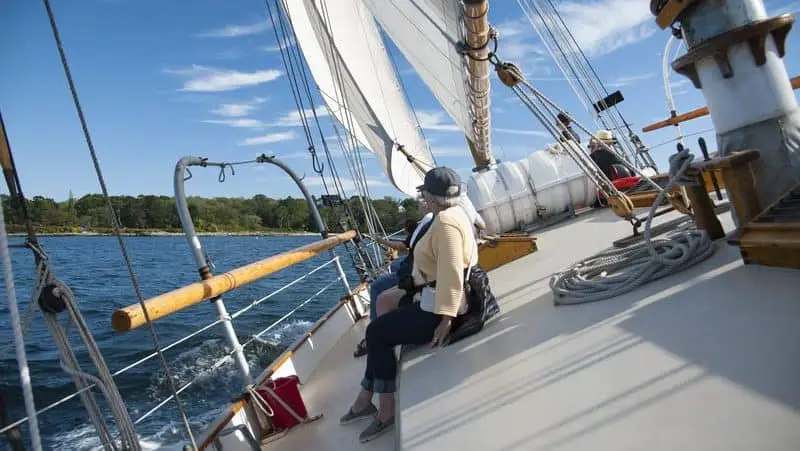
Your guests are more comfortable in a catamaran as the sailing experience doesn’t translate water resistance and wind to the vessel’s interior as much as it does in a monohull. Monohulls get hit by waves that pass between the two hulls of a catamaran.
As for physically sailing a catamaran-design vessel, the experience is different but not objectively easier. For instance, if you’re a seasoned monohull sailor, you’ll find what you’re used to much easier than adjusting two catamarans.
Final Thoughts
Catamarans are self-balancing and easy to learn, making them a preferred sailing choice among novices and time-strapped sailing enthusiasts. They have recently become symbols of luxury with comfortable interiors and ample living space.
Owner of CatamaranFreedom.com. A minimalist that has lived in a caravan in Sweden, 35ft Monohull in the Bahamas, and right now in his self-built Van. He just started the next adventure, to circumnavigate the world on a Catamaran!
Leave a Reply Cancel reply
Your email address will not be published. Required fields are marked *
Save my name and email in this browser for the next time I comment.
Recent Posts
Must-Have Boat Gear for Catamaran Sailors!
Sailing is probably the most gear-intensive activity I've ever done; there are so many decisions to be made about what gear to buy now, for tomorrow, and what to definitely never buy. The gear on...
6 Best Trailerable Trimarans For Bluewater and Coastal Sailing
Having a boat costs a lot of money, even when you are not using it, marina fees, etc. And once it is in the water most sailors never go very far from their "home marina" and sailing will be somewhat...
- Build Your World Cat
- Find A Dealer

- Cats Vs Mono
- Manufacturing Excellence
- A Better Way To Boat
- Testimonials
- Cat'n Around (Blog)
- 2025 Flip Book - View/Download
- 2024 Full Line Brochure - View/Download
- 25th Anniversary Commemorative Catalog - View/Download
- Owner’s Gallery
- World Cat Premiere Event
- Experience World Cat and A Better Way to Boat
- Event Calendar
- Cat’n Around Owners’ Events
- Current Promotions
- Monthly Newsletter
- Media Coverage
- Privacy Policy
- Take The Ultimate Sea Trial
- Request A Brochure

- Register Your World Cat
- Owner’s Manuals
- Parts Ordering
- Contact Your Dealer
- How-To Videos
Stay in the Know with World Cat
" * " indicates required fields
Where You Do Your Boating
Our history, true to our name, you’ll find our boats on virtually every ocean and lake in the world..
Over 80,000 customers across the globe can be found enjoying our catamarans. They’ve chosen our boats because World Cat delivers a smoother, more stable, more enjoyable experience from entertaining at the dock to navigating the deepest waters.
The origin of World Cat can be traced back over a quarter of a century to the beginning of our Glacier Bay Edition boats in America’s Pacific Northwest. Today, World Cat is the largest maker of power catamarans in the world. Located in Tarboro, North Carolina, our boats are precision crafted in a state-of-the-art 140,000 square foot facility.
While we build an array of boats in different sizes and configurations, each is a reflection of our mission to deliver the smoothest ride on water – making boating more enjoyable and giving boaters the comfort and confidence to cruise, fish, dive, and explore the water world around them.
From the South Pacific to Siberia, World Cats have safely carried thousands of boaters over tens of thousands of miles. Shouldn’t you share in that experience?
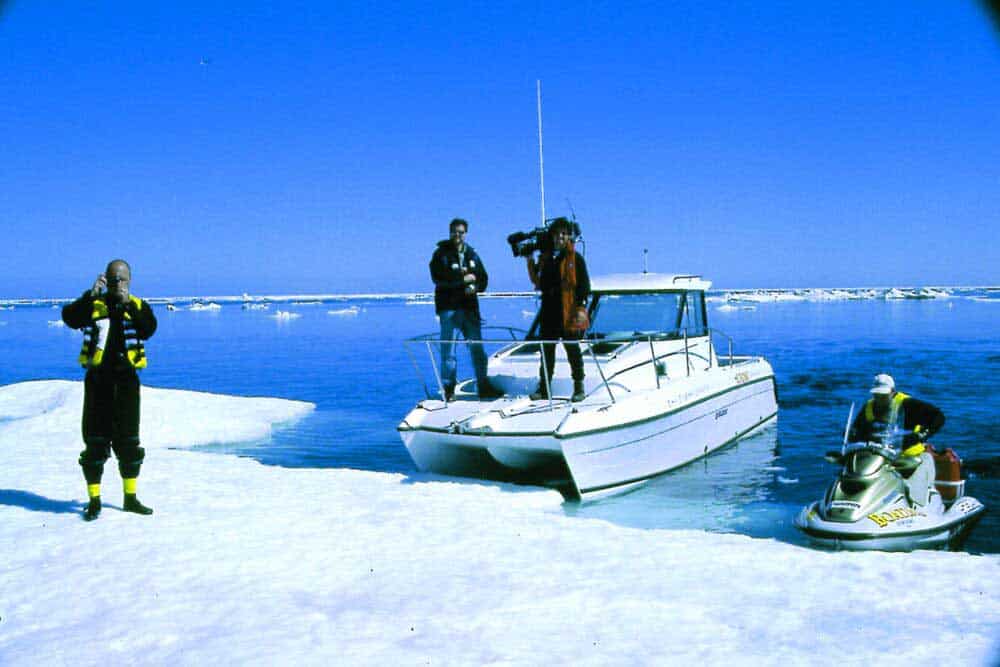
The first World Cat is built in Greenville, NC with a new mold and new hull. By fall of 1998, the World Cat brand is launched with three models: the 246 Sport Fisherman (SF), 266 Sport Cuddy (SC), and 266 Sport Fisherman (SF).
The 246DC Dual Console launches.
A World Cat wins the Bermuda Challenge – a run from Norfolk, VA to Bermuda.
The acquisition and renovation of a new facility is the start of transitioning production to Tarboro, NC.
Chris Peters sets the World Record Maco Shark in a 246SF.
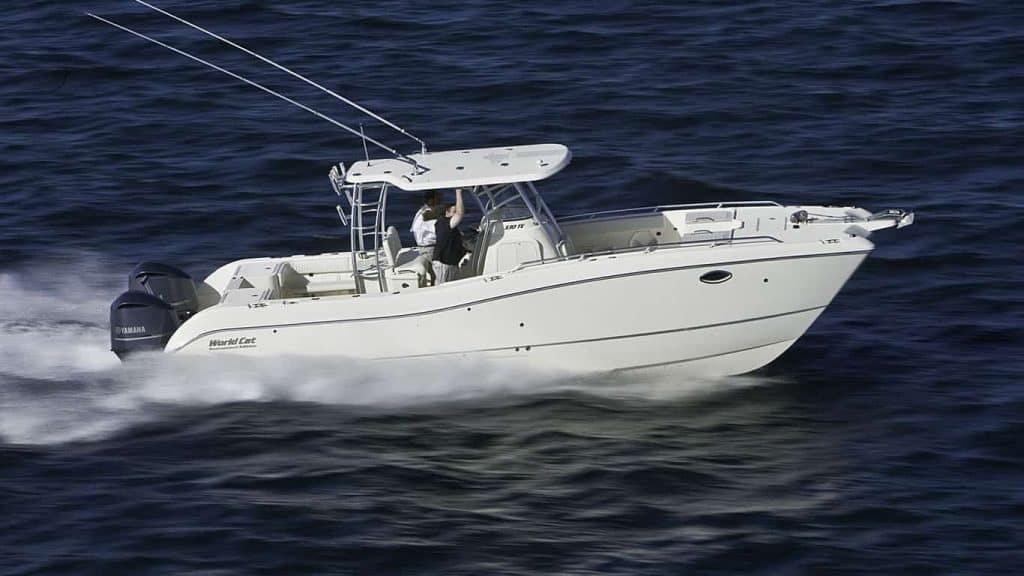
World Cat launches the 33’ TE Center Console, an innovative performance boat. At the time, it was the largest outboard boat in production and the first outboard boat to feature the new Suzuki 300HP 4-stroke engines, an absolute game changer.
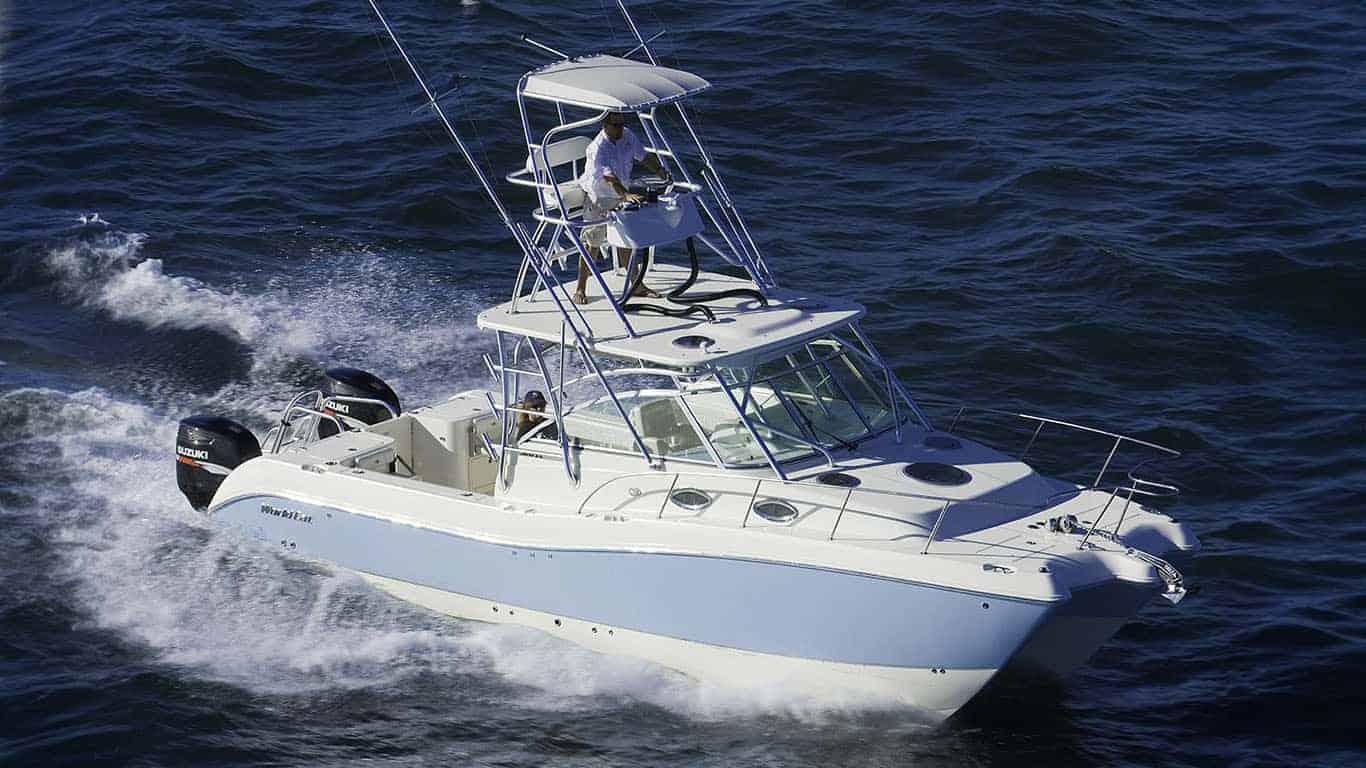
World Cat introduces a truly complex and innovative design with the 320EC, featuring World Cat’s first hull with a cabin and separate head.
World Cat secures its staying power by acquiring Glacier Bay and Livingston Catamaran Boats, while reinforcing its commitment to A Better Way To Boat™.
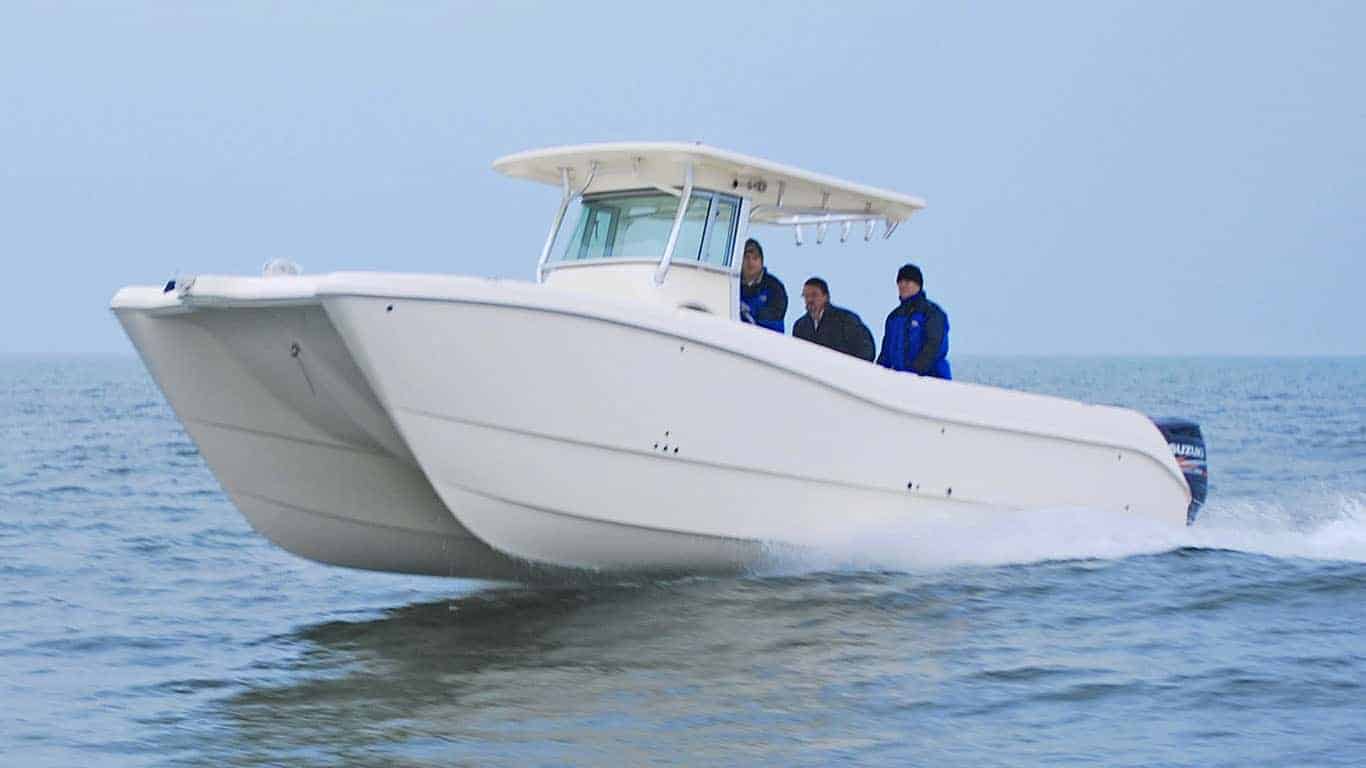
World Cat launches its first family fish friendly hull and deck design with the new 320CC Center Console.
World Cat officially enters the inshore audience with the launch of the 230CC and 230DC.
For the first time, World Cat launches a boat that does not focus on fishing first with the 230SD, featuring a refined family and cruising boating experience.
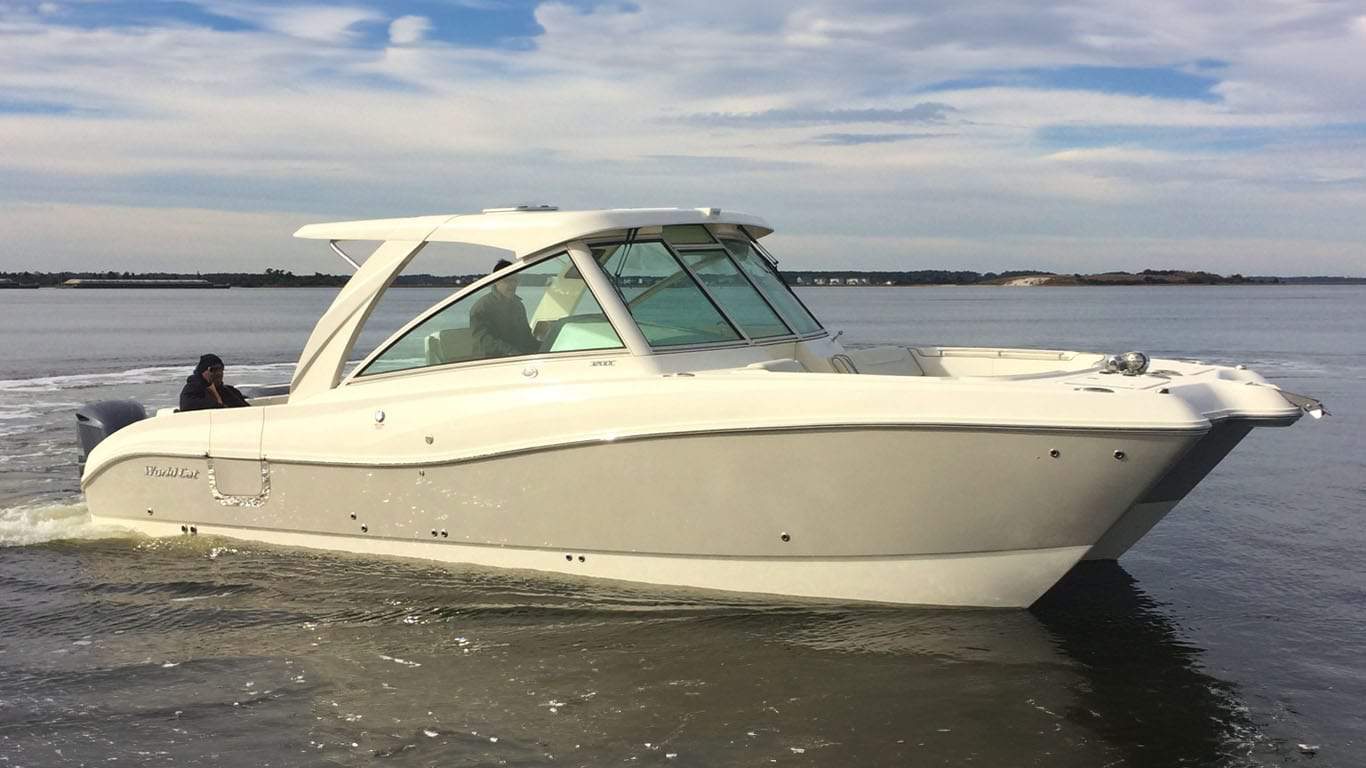
World Cat launches the largest dual console outboard boat on the market with the 320DC.
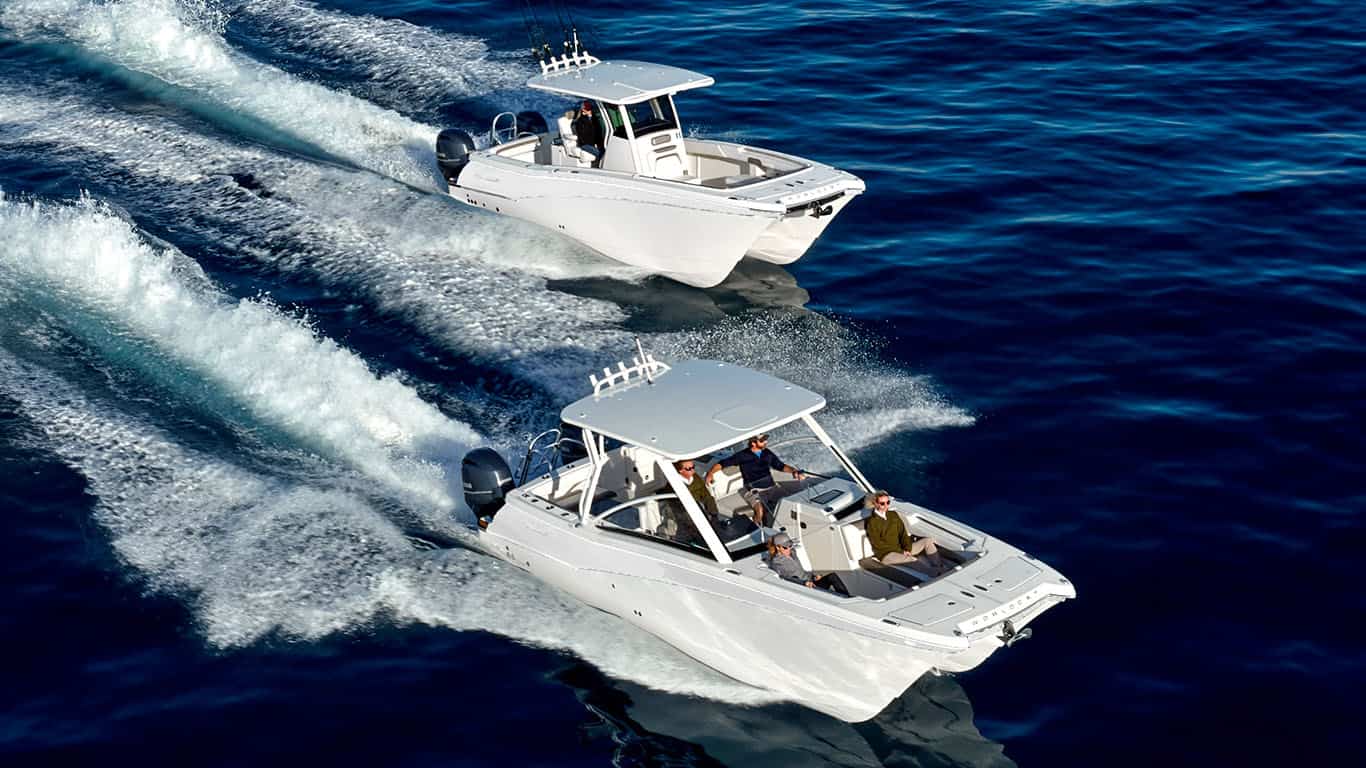
The 280CC-X and 280DC-X is launched, featuring a new hull style line, designed to deliver a refined look at top speeds.
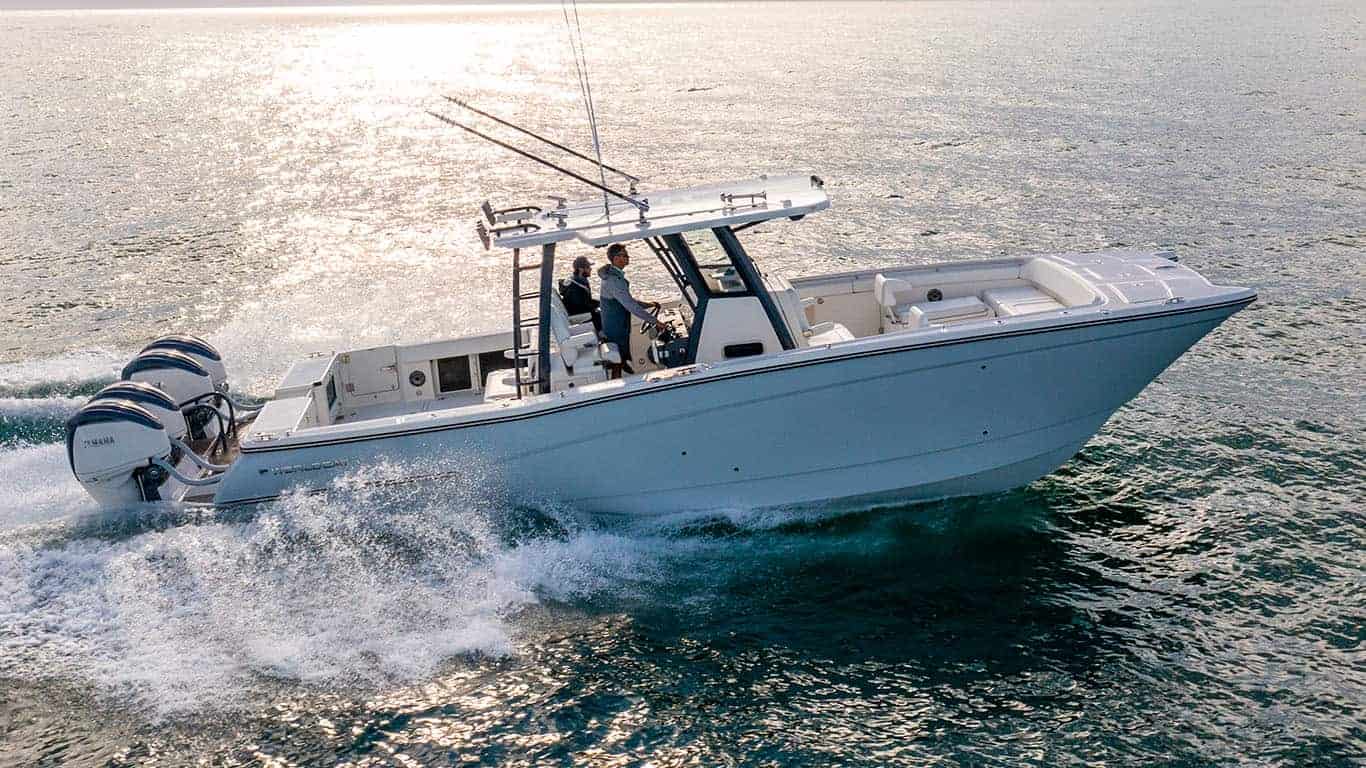
The new flagship 40’ hull emerges with the launch of the 400DC-X, becoming the largest dual console catamaran to ever hit the market. Quickly following was the 400CC-X Center Console featuring the innovative Cat-Track™ seating.
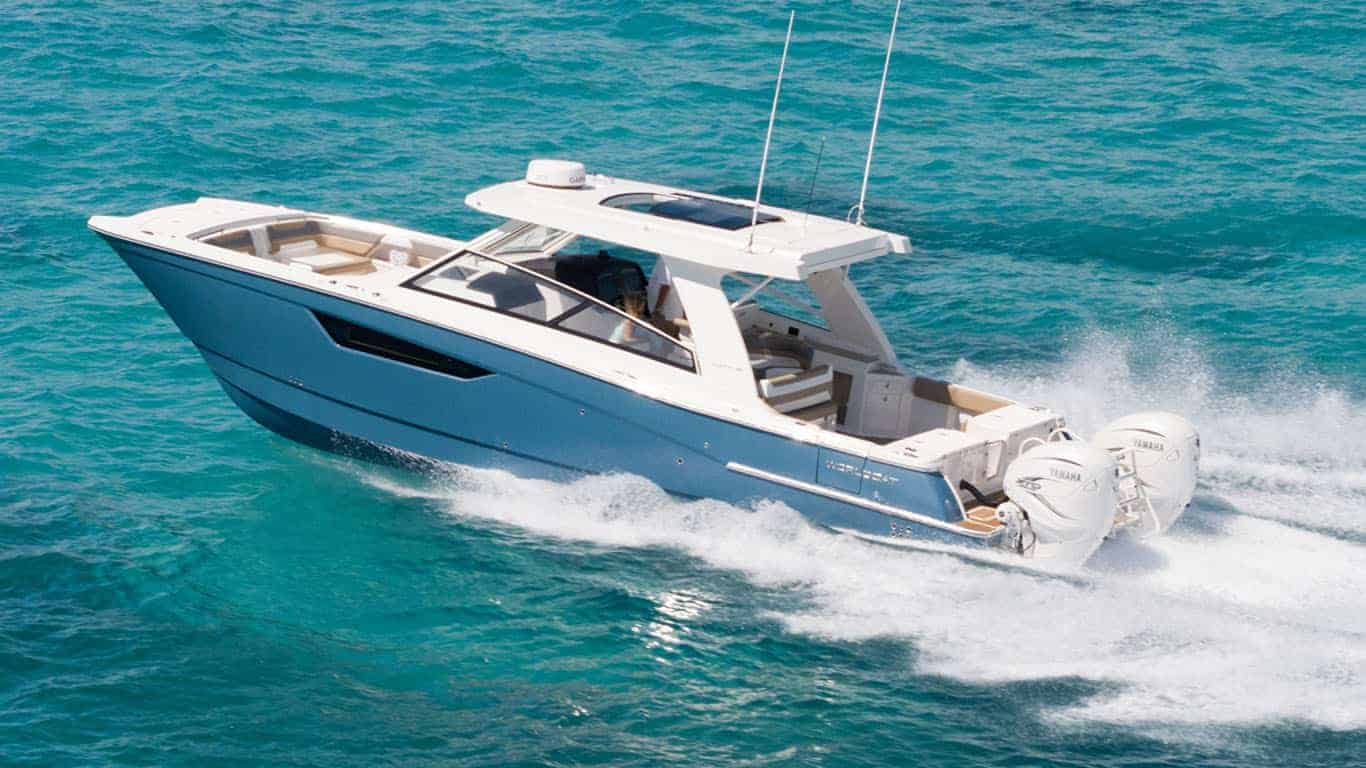
World Cat celebrates their 25th Anniversary year.
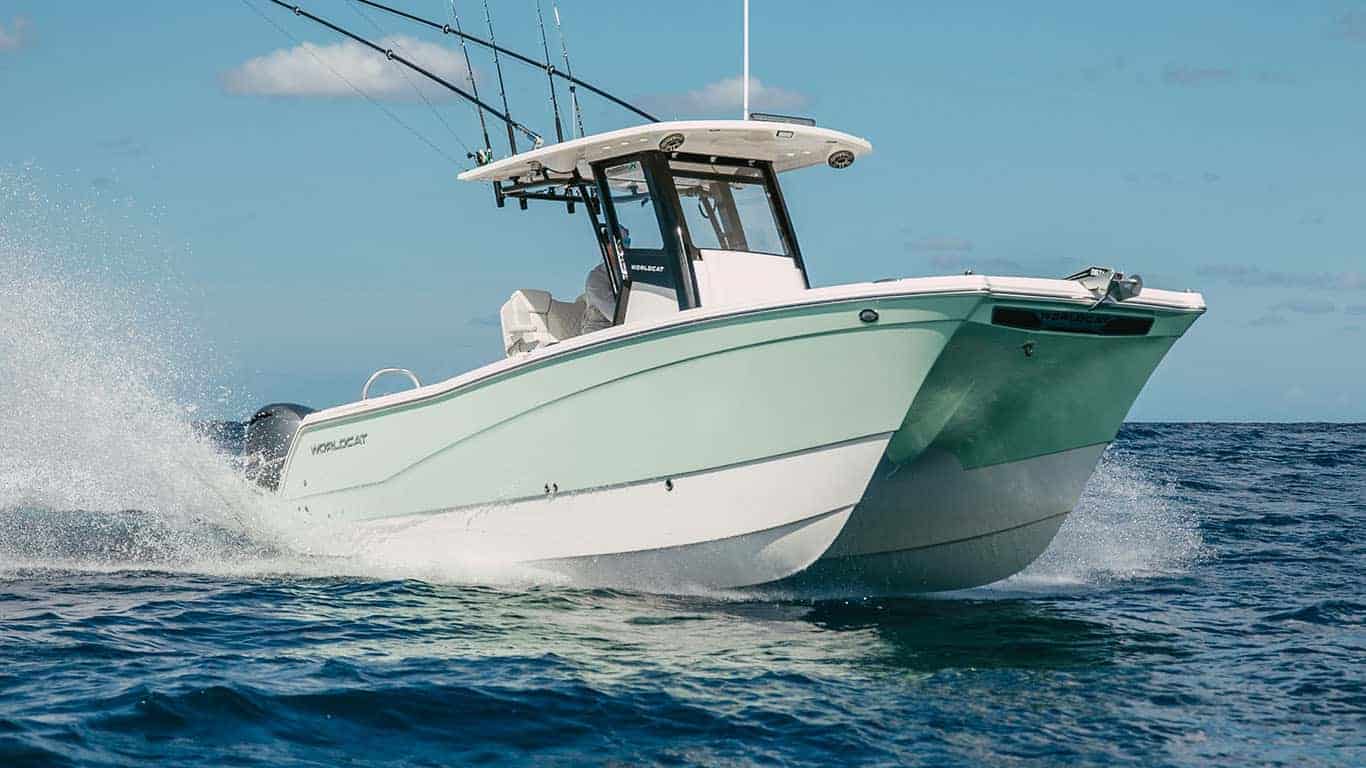
World Cat introduces the all-new 260CC-X.
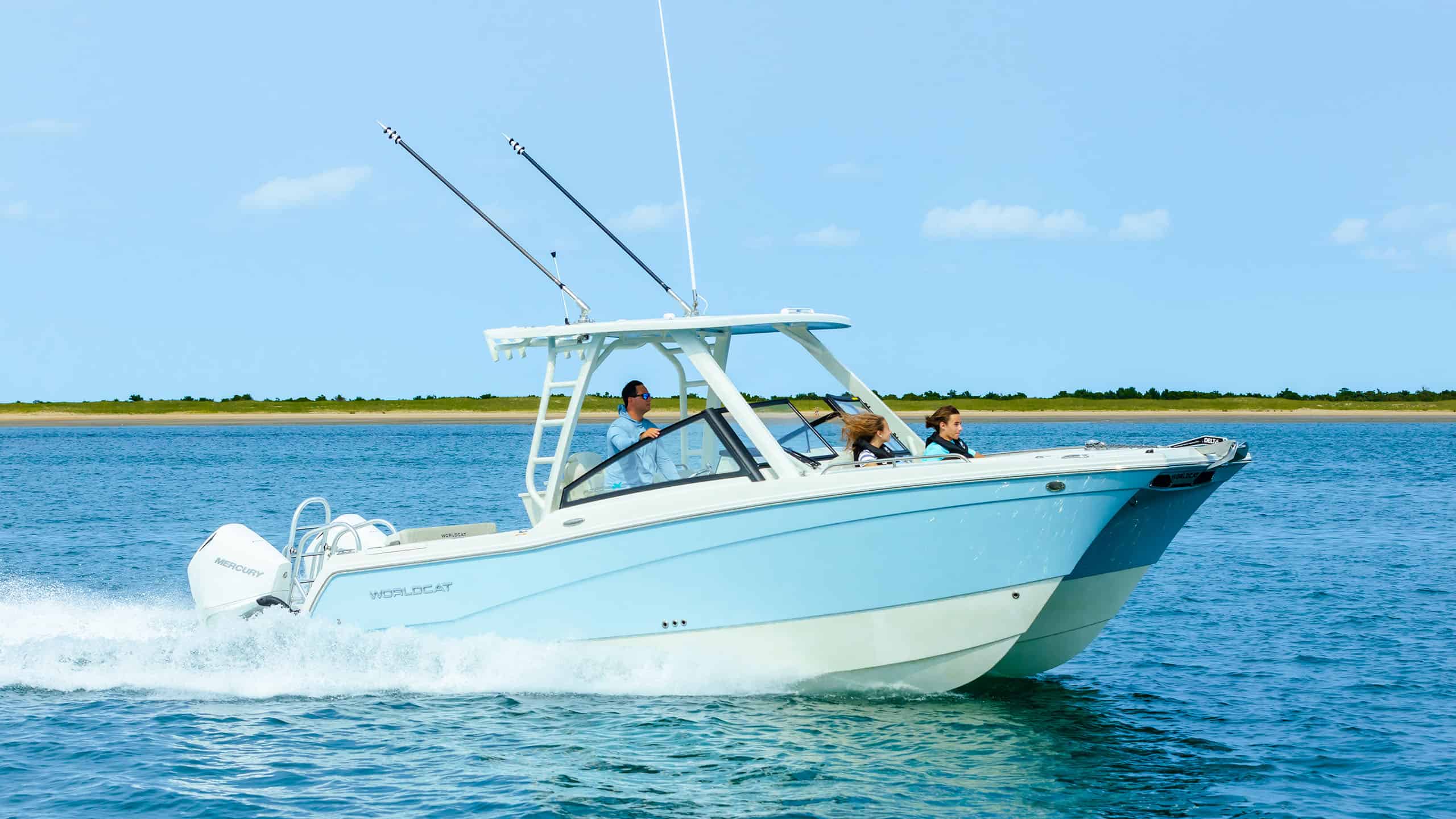
World Cat introduces the all-new 260DC-X.

catamaran (n.)
East Indies log raft, 1670s, from Hindi or Malayalam, from Tamil (Dravidian) kattu-maram "tied wood," from kattu "tie, binding" + maram "wood, tree." It also was used in the West Indies and South America.
Entries linking to catamaran
three-piece bathing suit with separate bra cups held on by Velcro, 1967, from tri- + bikini , falsely presumed as a compound in bi- . For a similar malformation from tri- , compare trimaran , "a central hull with a float on each side" (1949), based on non-PIE catamaran .
Trends of catamaran
More to explore, share catamaran.
updated on October 19, 2017
Dictionary entries near catamaran
- Daily Crossword
- Word Puzzle
- Word Finder
- Word of the Day
- Synonym of the Day
- Word of the Year
- Language stories
- All featured
- Gender and sexuality
- All pop culture
- Writing hub
- Grammar essentials
- Commonly confused
- All writing tips
- Pop culture
- Writing tips
Advertisement
[ kat- uh -m uh - ran , kat - uh -m uh -ran ]
- a vessel, usually propelled by sail, formed of two hulls or floats held side by side by a frame above them. Compare trimaran .
- a float or sailing raft formed of a number of logs lashed together, used in certain parts of India, South America, etc.
- Canadian Dialect. a wooden sled.
/ ˌkætəməˈræn /
- a sailing, or sometimes motored, vessel with twin hulls held parallel by a rigid framework
- a primitive raft made of logs lashed together
- old-fashioned. a quarrelsome woman
Word History and Origins
Origin of catamaran 1
Example Sentences
It involved a private island tour, catamaran cruise, visiting Rihanna’s childhood home and more.
We were about to sail back to Puerto Vallarta, but the catamaran barely moved.
I think the crew just didn’t know how to maneuver the catamaran very well, the sea was not very rough nor was it too windy.
I can paddle my catamaran against both wind and tide; why cannot you do the same?
They never tired, I think, of seeing me handle my giant “catamaran” and the (to them) mysterious harpoon.
We also started building a catamaran, with which to navigate the river when the floods had subsided.
She had easily forced a way for the catamaran through the branches, and once past, had drawn them together again.
Yamba cried out to me to lie flat on the catamaran, and hold on as tightly as I could until we reached smooth water again.
Related Words
- Cambridge Dictionary +Plus
Meaning of catamaran in English
Your browser doesn't support HTML5 audio
- cabin cruiser
- dragon boat
- As soon as the boat anchored, a catamaran put out, and brought Charlie and his followers to shore.
- Next morning we were visited by a party of natives from the neighbouring island, consisting of six men in a canoe, and one on a catamaran or raft.
- Soon we were surrounded with catamarans and canoes, with three or four natives in each.
- The horses and cows were taken on a species of catamaran, or large raft, that is much used in those mild seas, and which sail reasonably well a little off the wind, and not very badly on.
- When we reached the lagoon, a catamaran with three natives on it came off to us.
Examples of catamaran
Translations of catamaran.
Get a quick, free translation!

Word of the Day
a day that you spend somewhere that is not your home or usual place of work

It’s not really my thing (How to say you don’t like something)

Learn more with +Plus
- Recent and Recommended {{#preferredDictionaries}} {{name}} {{/preferredDictionaries}}
- Definitions Clear explanations of natural written and spoken English English Learner’s Dictionary Essential British English Essential American English
- Grammar and thesaurus Usage explanations of natural written and spoken English Grammar Thesaurus
- Pronunciation British and American pronunciations with audio English Pronunciation
- English–Chinese (Simplified) Chinese (Simplified)–English
- English–Chinese (Traditional) Chinese (Traditional)–English
- English–Dutch Dutch–English
- English–French French–English
- English–German German–English
- English–Indonesian Indonesian–English
- English–Italian Italian–English
- English–Japanese Japanese–English
- English–Norwegian Norwegian–English
- English–Polish Polish–English
- English–Portuguese Portuguese–English
- English–Spanish Spanish–English
- English–Swedish Swedish–English
- Dictionary +Plus Word Lists
- English Noun
- Translations
- All translations
To add catamaran to a word list please sign up or log in.
Add catamaran to one of your lists below, or create a new one.
{{message}}
Something went wrong.
There was a problem sending your report.

Nautical Terms: Where Did They Come From?

For instance, the origination of the word “posh” means “port out, starboard home”, referring to the preferred cabins, overlooking the continent, on the way to India. Who knew?
The meaning of some of the more common phrases, like “rocking the boat” or “on an even keel” are easier to figure out but some of them will leave you confounded! Here are some other nautical terms that we use all the time!
All hands on deck: an order for all crew members to assemble in an emergency – a call for everyone available to be available to assist with an activity or event.
Anchor’s aweigh : a comment made when a vessel’s anchor is clear
Bitter end: the last segment of a rope or chain – the final portion of a difficult or unpleasant task or occurrence
Even keeled: well balanced — said of a vessel – steady, even tempered
Shake a leg: make haste – move quickly
Stem to stern: the forward end of the bow to the rear part of the vessel; the entire vessel – front to back, beginning to end, or all-inclusive
Wide berth: a significant distance between one vessel and another – plenty of space
Clean Bill of Health: This widely used term has its origins in the document issued to a ship showing that the port it sailed from suffered from no epidemic or infection at the time of departure.
Down the hatch: This is a drinking expression that seems to have its origins in sea freight, where cargoes are lowered into the hatch. First used by seamen, it has only been traced back to the turn of the century.
Port and Starboard : Port is to the left of a ship; starboard, to the right, when facing the bow. So unlike “left” and “right”, “port” and “starboard” refer to fixed locations on a boat. In the early days of boating, before ships rudders were on their centerlines, boats were controlled using a steering oar. Most sailors were right-handed, so the steering oar was placed over or through the stern’s right side. Combining two Old English words “stéor” meaning steer and “bord” meaning side of a boat, the word “starboard” soon came to refer to the steering side which was the right side of the boat. As boats and their steering oars grew in size, it became much easier to tether to the dock using the opposite side from the oar. This left side became known as larboard or “the loading side.” But it was easily confused with starboard and was replaced with “port” since when docked, this is the side that faced the port. Land HO! : This cry let the crew know land had been spotted and the voyage’s end is near. Landlubber : “land lover” describing someone who is not at ease at sea, on a boat, or tends to get seasickness. Show One’s True Colors : Hoisting flags to declare the ship’s origin was commonplace, but not all captains told the truth. Flying false flags was often used to trick enemies. The term has become familiar with non-sailors with showing your true colors meaning revealing falsehood or true nature. Scuttlebutt : In the 1800s, the fresh drinking water barrel was called a scuttlebutt. Like in offices where the water cooler is a gathering place to chat and gossip with each other, the scuttlebutt was “information central”. By the 1900s, the term scuttlebutt became a synonym for information. Shanghai : The city in China was often the location of many kidnappings in which people were pressed into service aboard ships. To be “Shanghaied” is to be taken or betrayed. Loose Cannon : When a cannonball stored on a ship jumped out of its storage slot and rolled across the deck, usually wildly depending on seas, it created a very dangerous situation for sailors, especially those tasked with retrieving it. The phrase has come to describe a person who is unpredictable most often in a perilous way. Three Sheets to the Wind : Before backup engines made loss of sail power less dangerous, losing sails to the wind usually meant all control of the ship was lost. So the term has come to describe people who over-imbibe losing all control of themselves. Hunky Dory : An Anglicized pronunciation of “honcho dori”, the name of the main street that led sailors back to the port. There are 2 suggestions as to how its meaning of being “ok” or “perfect” came to being:
- If they found honcho dori, they knew they were headed the right way back to their ship…perhaps in an inebriated state, this was quite helpful.
- Others suggest that the road catered to the sailors’ “needs” making them feel hunky-dory.
Ahoy : “Hoy” was a medieval English greeting from the Dutch “hoi”. Sometime before its first written reference in the 1751 novel, The Adventures of Peregrine Pickle, by Tobias Smollett, “ahoy” became a signal word between sailors on passing boats. By 1813, “ahoy” was widely used in the English language becoming a fun greeting outside the maritime world and quickly became a familiar term in other languages. In the Doldrums : The doldrums are an area near the equator where surface wind is sparse with little chance of filling one’s sails putting boats at a standstill. The phrase has come to mean moving slowly or stuck in a standstill outside nautical situations. Turn the Corner : This idiom was used by sailors to describe arriving into safer waters after passing critical points such as the Cape of Good Hope at the southern tip of Africa or Cape Horn at the south end of South America. Pipe Down : The boatswain communicated tasks to the crew by sounding through a pipe. One tone was to step down from duty for the night or “pipe down”. Toe the Line : While under inspection, sailors were expected to stand in a straight line with their toes behind deck planking, a “line”. All Hands on Deck : During trouble or when called for an inspection, captains called out for all crew to be present, accounted for, and working as directed. Now the phrase is used frequently whether on a boat or not. Long Shot : When a cannon was shot at a target further away, the probability of hitting the target were low without luck. Feeling Blue : If a ship’s officer died at sea, vessels raised a blue flag and painted a blue stripe on the hull as a sign of mourning. Today, the term has been more generalized to mean feelings of sadness. High and Dry : If a ship was caught in low tide or ran aground a sandbar or shoals, it was easily stranded with no hope of recovery. It was stuck up out of the water. Dead in the Water : Lack of wind kept ships from making progress were often called being “dead in the water”. The phrase today is often heard to refer to a severe situation where no progress seems possible. Learn the Ropes : Sails were raised and lowered with ropes. Knowing how to use the ropes to control the sails enabled a boat to take the best advantage of the wind and sail safely. So while learning the ropes was literal back then, today, it means to become completely familiar with a skill or topic. Hand Over Fist : Raising and lowering sails via a pulley system required placing one hand over the other in a consistent movement. It was a term used to describe being quick or deft in accomplishing the job.
Here are a few more related to the origin of calling a toilet on a boat the head and a some less than savory terms.
See some more fun terms and phrases from Yachting & Boating World
Estelle Cockcroft
Join our community.
Get the latest on catamaran news, sailing events, buying and selling tips, community happenings, webinars & seminars, and much more!
2 thoughts on “Nautical Terms: Where Did They Come From?”
What about the term “the whole nine yards?” Sailing or football?
Mart as far as I know, the phrase “the whole nine yards” referred to the bullets for the machine guns used in American combat planes of WW2 were in chains twenty-seven feet in length. So, if a pilot was able to fire all his bullets off at one target, he was said to have given his adversary ‘the full/whole nine yards’.
Leave a Comment Cancel Reply
Your email address will not be published. Required fields are marked *
Save my name, email, and website in this browser for the next time I comment.
Recent Posts

Top 10 Reasons to Sell (and Sail) Your Catamaran in Annapolis, MD
We have a new home in Annapolis! The office is located in Annapolis, Maryland

Top 10 Reasons to Sell (and Sail) Your Catamaran in Texas
Our Texas Office is located in the Watergate Marina Center in Clear Lake Shores,
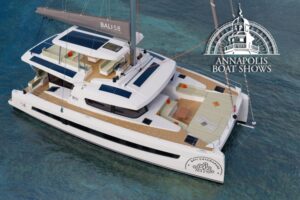
Annapolis Boat Show 2024
Meet with our team! Want to learn more about the Bali and Catana

Exploring the Catana OC 50 Catamaran: A Comprehensive Overview
The Catana OC 50 Catamaran, the latest addition to the Catana Ocean Class series,

For more than 30 years, we have been a part of the catamaran community and created Catamaran Guru™ to encourage and educate all the aspiring sailing out there. We understand the dream of traveling the world by catamaran and created a one-stop-shop to make that dream a reality for you.

- Stephen & Estelle
- Testimonials
Get Started
- Yacht Sales
- Used Yachts
- Charter Management
- Boat as Business Programs
- Seminars & Events
Words and phrases
Personal account.
- Access or purchase personal subscriptions
- Get our newsletter
- Save searches
- Set display preferences
Institutional access
Sign in with library card
Sign in with username / password
Recommend to your librarian
Institutional account management
Sign in as administrator on Oxford Academic
catamaran noun
- Hide all quotations
What does the noun catamaran mean?
There are four meanings listed in OED's entry for the noun catamaran , one of which is labelled obsolete. See ‘Meaning & use’ for definitions, usage, and quotation evidence.
catamaran has developed meanings and uses in subjects including
Entry status
OED is undergoing a continuous programme of revision to modernize and improve definitions. This entry has not yet been fully revised.
How common is the noun catamaran ?
| 1760 | 0.018 |
| 1770 | 0.022 |
| 1780 | 0.03 |
| 1790 | 0.042 |
| 1800 | 0.059 |
| 1810 | 0.077 |
| 1820 | 0.089 |
| 1830 | 0.097 |
| 1840 | 0.1 |
| 1850 | 0.11 |
| 1860 | 0.11 |
| 1870 | 0.12 |
| 1880 | 0.13 |
| 1890 | 0.12 |
| 1900 | 0.12 |
| 1910 | 0.11 |
| 1920 | 0.093 |
| 1930 | 0.081 |
| 1940 | 0.09 |
| 1950 | 0.099 |
| 1960 | 0.12 |
| 1970 | 0.15 |
| 1980 | 0.19 |
| 1990 | 0.21 |
| 2000 | 0.23 |
| 2010 | 0.24 |
How is the noun catamaran pronounced?
British english, u.s. english, where does the noun catamaran come from.
Earliest known use
The earliest known use of the noun catamaran is in the late 1600s.
OED's earliest evidence for catamaran is from 1697, in the writing of William Dampier, buccaneer and explorer.
catamaran is a borrowing from Tamil.
Etymons: Tamil kaṭṭa-maram .
Nearby entries
- catalysis, n. 1655–
- catalysor, n. 1901–
- catalysotype, n. 1853–
- catalyst, n. 1902–
- catalytic, adj. & n. 1836–
- catalytical, adj. 1889–
- catalytically, adv. 1845–
- catalytic converter, n. 1955–
- catalytic cracker, n. 1951–
- catalytic cracking, n. 1927–
- catamaran, n. 1697–
- catamaran, v. 1820–
- catamenia, n. 1764–
- catamenial, adj. 1851–
- catamidiate, v. 1656
- catamite, n. ?1552–
- catamited, adj. 1697
- catamiting, adj. a1641–
- catamount, n. 1664–
- catamountain | cat o' mountain, n. ?a1475–
- catanadromous, adj. 1753
Thank you for visiting Oxford English Dictionary
To continue reading, please sign in below or purchase a subscription. After purchasing, please sign in below to access the content.
Meaning & use
Pronunciation, compounds & derived words, entry history for catamaran, n..
catamaran, n. was first published in 1889; not yet revised.
catamaran, n. was last modified in July 2023.
Revision of the OED is a long-term project. Entries in oed.com which have not been revised may include:
- corrections and revisions to definitions, pronunciation, etymology, headwords, variant spellings, quotations, and dates;
- new senses, phrases, and quotations which have been added in subsequent print and online updates.
Revisions and additions of this kind were last incorporated into catamaran, n. in July 2023.
Earlier versions of this entry were published in:
OED First Edition (1889)
- Find out more
OED Second Edition (1989)
- View catamaran in OED Second Edition
Please submit your feedback for catamaran, n.
Please include your email address if you are happy to be contacted about your feedback. OUP will not use this email address for any other purpose.
Citation details
Factsheet for catamaran, n., browse entry.

IMAGES
VIDEO
COMMENTS
A catamaran ( / ˌkætəməˈræn /) (informally, a "cat") is a watercraft with two parallel hulls of equal size. The distance between a catamaran's hulls imparts resistance to rolling and overturning. Catamarans typically have less hull volume, smaller displacement, and shallower draft (draught) than monohulls of comparable length.
catamaran, twin-hulled sailing and powered boat developed for sport and recreation in the second half of the 20th century. Its design is based on a raft of two logs bridged by planks that had earlier been used by peoples in the Indonesian archipelago and throughout Polynesia and Micronesia. Early catamarans were up to 21.3 metres (70 feet) long, originally paddled by many men, and used for ...
A catamaran (from Tamil kattumaram) is a type of multihulled boat or ship consisting of two hulls, or Vakas, joined by a frame, formed of Akas.Catamarans can be sail- or engine-powered. The catamaran was first discovered being used by the paravas, a fishing community in the southern coast of Tamil Nadu, India.Catamarans were used by the ancient Tamil Chola dynasty as early as the fifth century ...
Catamarans: A Complete Guide to Multihull Boats. Catamarans have been a part of sailing history for centuries and continue to be popular for their stability, spaciousness, and performance. Developed by various cultures around the world, the principles of catamaran design have evolved over time to become optimized for both pleasure cruising and racing. . This complete guide will help you ...
The history of catamarans among the early Austronesian people is tied to that of outrigger canoes, which are boats that are stabilized through the use of a separate floating device which sits alongside the main hull. There is controversy among academics over whether outrigger canoes developed as scaled down versions of catamarans or catamarans ...
Author: Dmitry. Updated: November 10, 2023. Catamarans are boats with two connected hulls that are joined by a bridge. Because they are faster, more stable, and capable of carrying larger cargo than their monohull counterparts, catamarans are growing in popularity. Contents show.
A History Of The Catamaran. It is believed that the first people to use a catamaran design were those living in Australasia. The origin of the catamaran is believed to be southeast Asia. The succession of boat design in this region was actually very interesting. The beginning of boats in the area was simple, albeit conventional rafts.
A catamaran is a twin-hull boat with two equally-sized hulls placed side by side. They're powered by engines, sails, or both—and they're known for efficiency and speed. Catamarans are the most common kind of multihull boat. In this article, we'll go over the characteristics of catamarans and how to differentiate them from other types of ...
catamaran: [noun] a vessel (such as a sailboat) with twin hulls and usually a deck or superstructure connecting the hulls.
The first Catamaran was created in India, borrowing its modern name from the original Tamil word kattumaram, meaning "logs bound together". The first design was simply a raft made of tree trunks, built in the fishing communities of Tamil Nadu in southern India and used to invade several Southeast Asian countries as early as the 5th century.
A catamaran is a watercraft with two parallel hulls of equal size. The distance between a catamaran's hulls imparts resistance to rolling and overturning. Catamarans typically have less hull volume, smaller displacement, and shallower draft (draught) than monohulls of comparable length. The two hulls combined also often have a smaller hydrodynamic resistance than comparable monohulls ...
Types Of Catamarans. Catamarans come in a variety of shapes and sizes, from luxurious yachts to fast-moving racing boats. They offer a unique sailing experience, with their twin hulls providing stability and comfort while still able to reach high speeds. Catamarans can be powered by engines or sail, enabling them to move swiftly through the water.
The history of catamarans can be traced back thousands of years to ancient seafaring cultures. The earliest known recorded usage of the term catamaran dates back to 17th century Tamil sailors of the Coromandel Coast in India. The term catamaran is derived from the Tamil word kattumaram which means tied wood.
The brand's catamarans are fitted with daggerboards, and material variety includes Kevlar in regions of impact and carbon fiber in the lower-weight areas. Lagoon catamarans have a history of using solid glass below water level, but newer models have a balsa core in the submerged region. While the specifics of composting technology and ...
Lagoon Catamarans is one of the most well-known and respected names in the catamaran industry. With a history dating back to 1984, Lagoon has been at the forefront of catamaran design and innovation for over three decades. Their catamarans are renowned for their spaciousness, comfort, and luxurious amenities.
The origin of World Cat can be traced back over a quarter of a century to the beginning of our Glacier Bay Edition boats in America's Pacific Northwest. Today, World Cat is the largest maker of power catamarans in the world. Located in Tarboro, North Carolina, our boats are precision crafted in a state-of-the-art 140,000 square foot facility.
catamaran (n.)East Indies log raft, 1670s, from Hindi or Malayalam, from Tamil (Dravidian) ... "damage, loss, failure; disaster, misfortune, adversity," a word of obscure origin. Early etymologists associat. master. late Old English mægester "a man having control or authority over a place; a teacher or tutor of children," from Latin magister ...
CATAMARAN definition: 1. a sailing boat that has two parallel hulls (= floating parts) held together by a single deck…. Learn more.
Activities: Overnight Cruising, Racing, Fishing, Day Sailing, Liveaboards. Length Range: 25 - 160 ft. Average price: $607,000. 2-12 cabins. Whether you're shopping for a new fishing boat, a sailing cruiser, or anything in-between, you'll come across catamarans.
Catamaran definition: a vessel, usually propelled by sail, formed of two hulls or floats held side by side by a frame above them.. See examples of CATAMARAN used in a sentence.
CATAMARAN meaning: 1. a sailing boat that has two parallel hulls (= floating parts) held together by a single deck…. Learn more.
First used by seamen, it has only been traced back to the turn of the century. Port and Starboard: Port is to the left of a ship; starboard, to the right, when facing the bow. So unlike "left" and "right", "port" and "starboard" refer to fixed locations on a boat. In the early days of boating, before ships rudders were on their ...
There are four meanings listed in OED's entry for the noun catamaran, one of which is labelled obsolete. See 'Meaning & use' for definitions, usage, and quotation evidence. See 'Meaning & use' for definitions, usage, and quotation evidence.